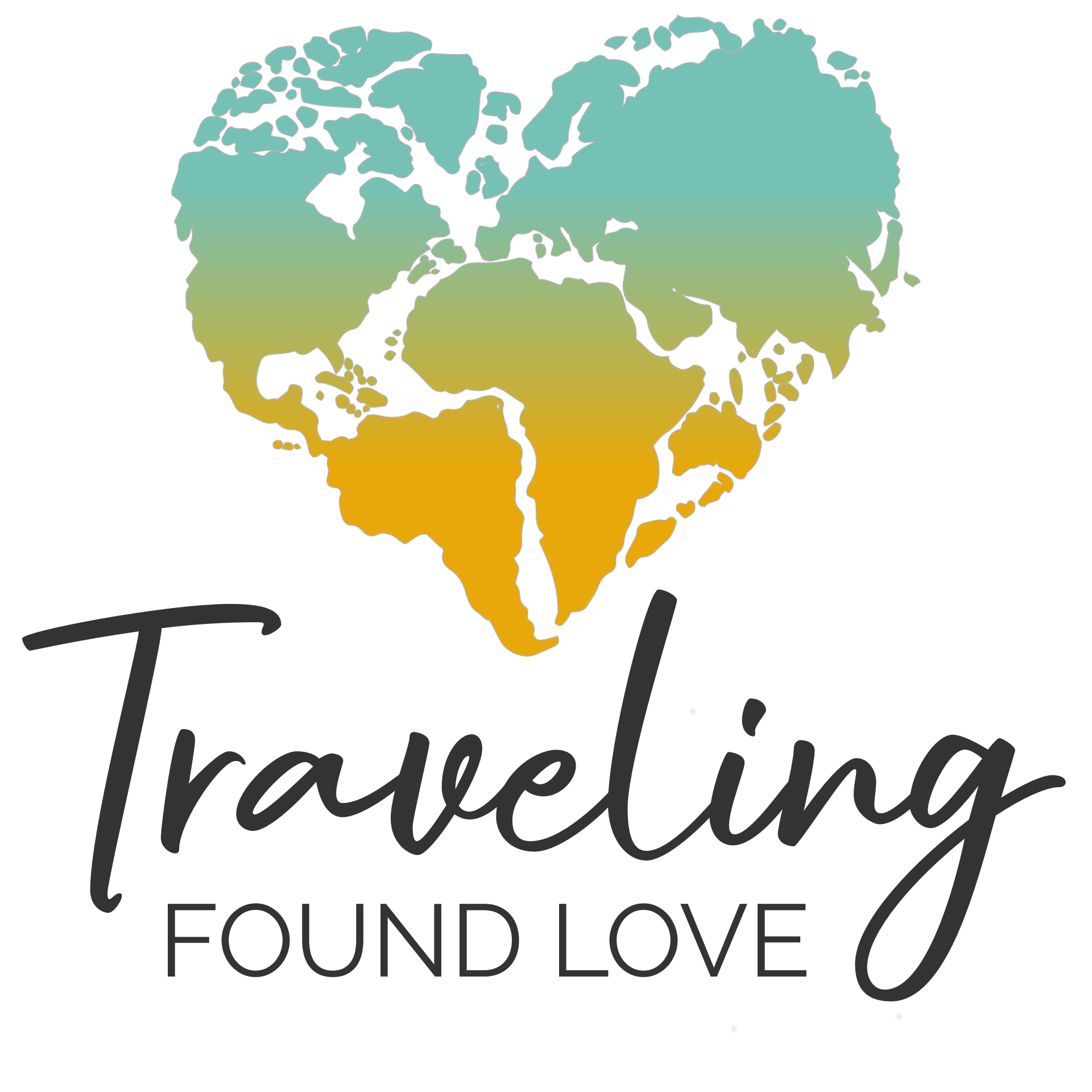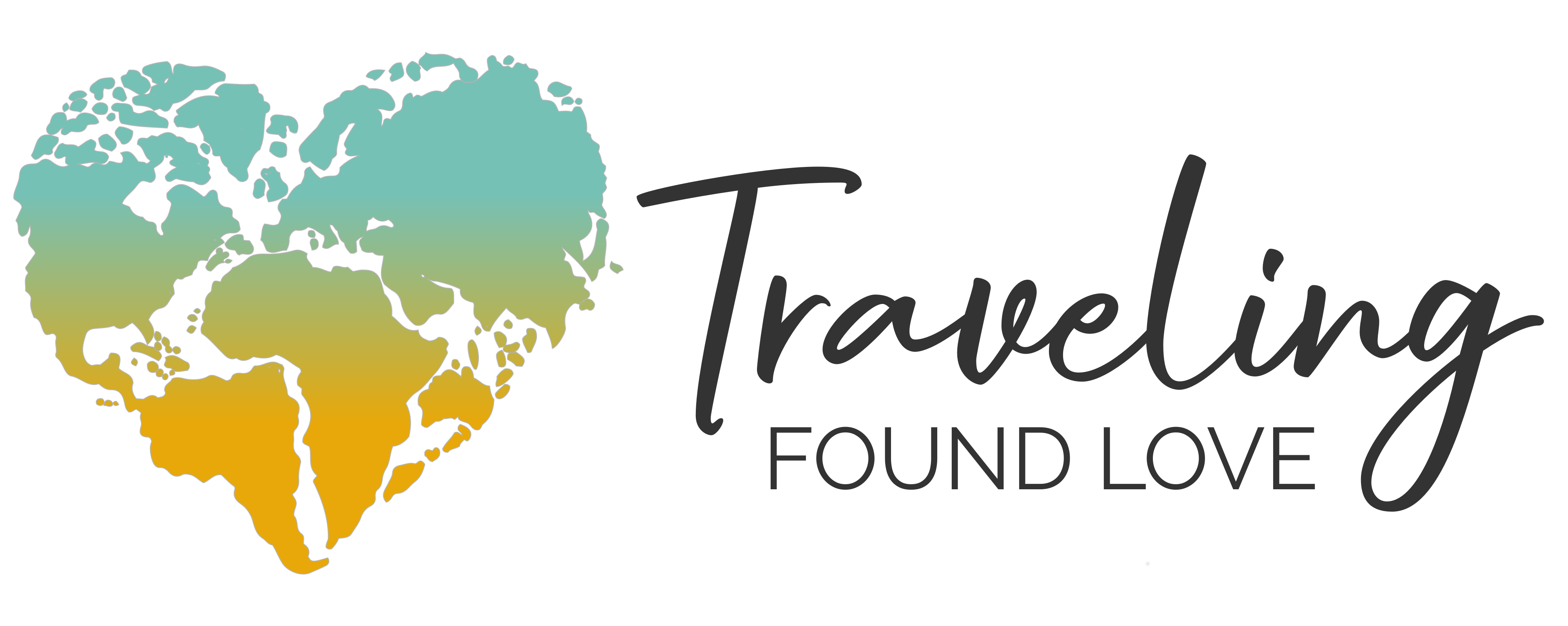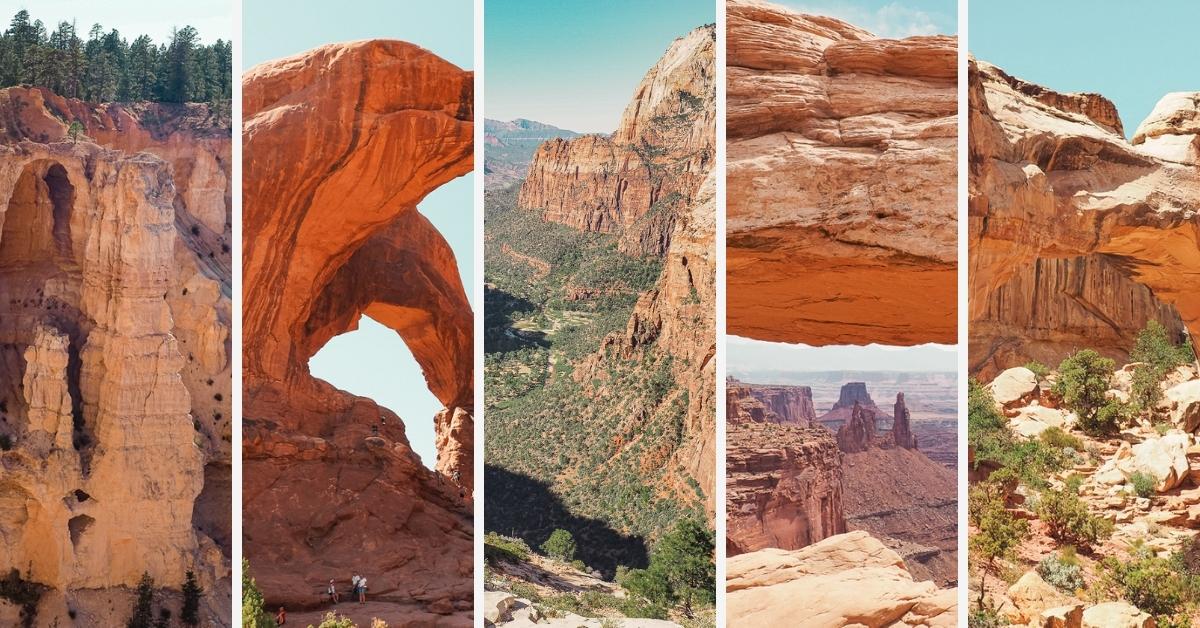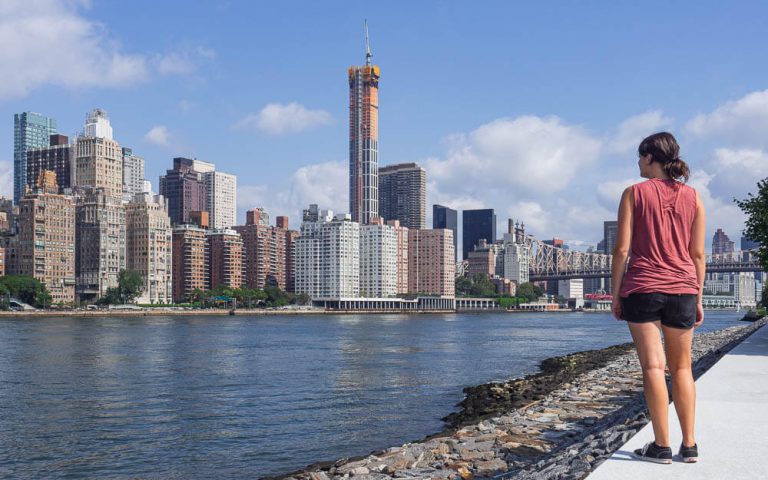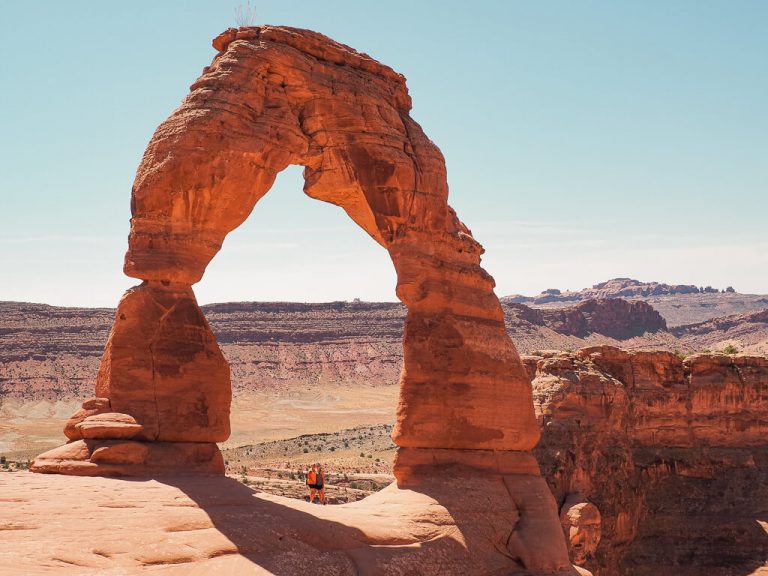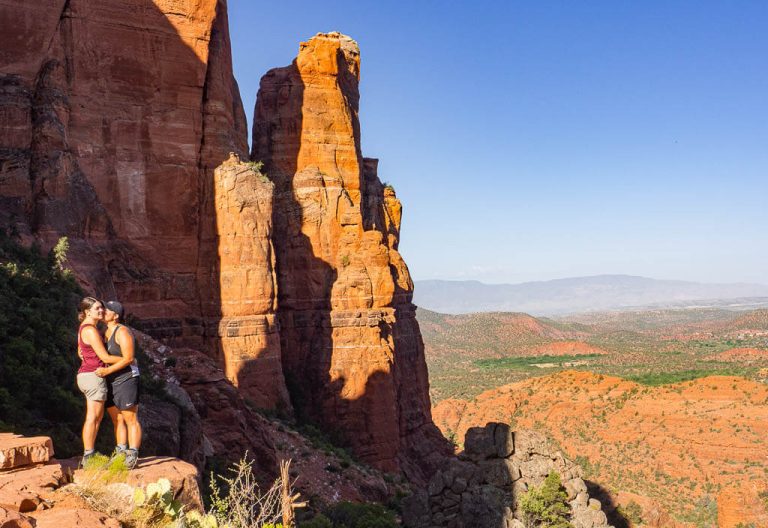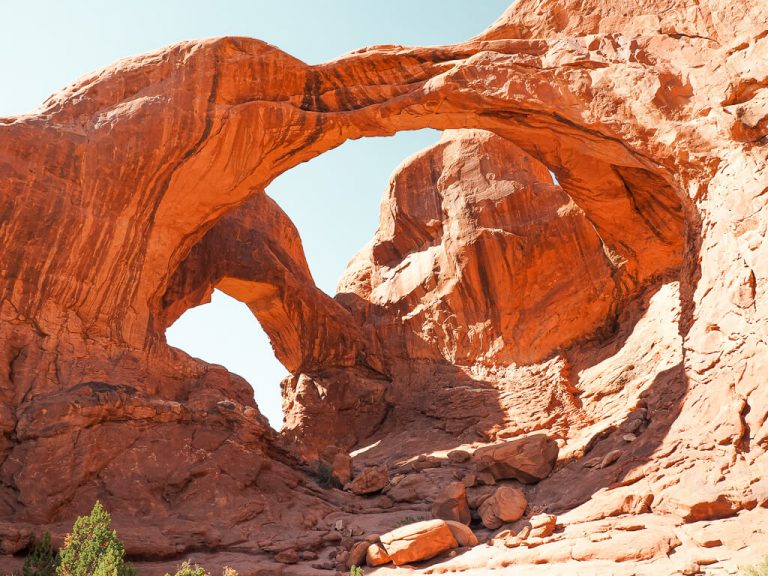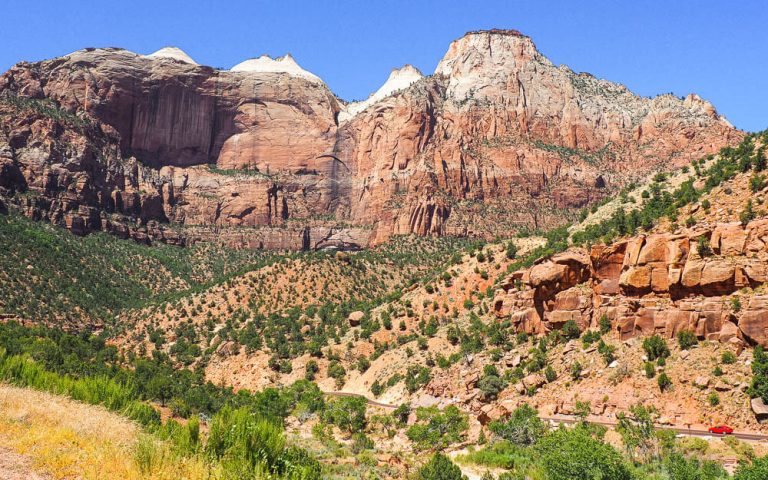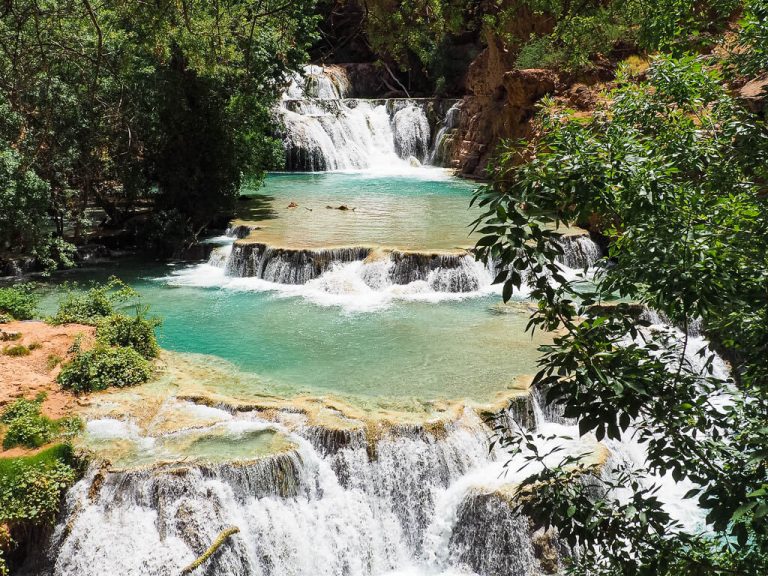Explore Utahs National Parks: How to Visit the Mighty 5
Utah is one of the most beautiful states in the U.S., having not just one or two, but 5 exceptional national parks in close proximity to each other. Did you know that it is the state with the third-highest amount of national parks in the U.S.? That makes it a perfect place for a Utahs National Park road trip.
Each of the Utah parks have unique landscapes and offers unforgettable outdoor adventures:
- Arches National Park: See the highest concentration of natural arches.
- Bryce Canyon National Park: Walkthrough unique hoodoo gardens.
- Capitol Reef National Park: Navigate yourself through narrow canyon walls.
- Canyonlands National Park: Get a birds-eye view of the vast, deep canyon landscape.
- Zion National Park: Hike some of the most thrilling hikes in the U.S.
Doesn’t that sound like an adventurous trip? And that is just a quick excerpt of all the can’t miss activities in Utah’s National Parks. Get the best route, in-depth details of the best things to do in each park, and more things you need to know for your trip.
Our Other Resources for Utahs National Park:
- Zion National Park Itinerary: Spend 1-5 Days
- Bryce Canyon in One Day: What Not to Miss!
- How to See Arches National Park in One Day
- Explore 10 Striking Capitol Reef Hikes in the Fruita District
- The Best of Island in the Sky Canyonlands National Park
- Plan a Trip from Zion to Bryce Canyon: 2 Utah National Parks
- How to Save Money with the America the Beautiful Pass
This post may contain affiliate links. If you make a purchase through them, we get a small commission at no extra cost to you. It helps us create free content for you to enjoy. Learn more about our disclaimer here. Thanks for your support!
Best Utahs National Park Road Trip Routes
If you are planning a Utah National Parks road trip, you will need anywhere from 7-10 days.
The driving time between the parks in Utah is not too long but you will still need around 7 hours to complete the 382 miles from Arches National Park to Zion National Park or the other way around.
The short driving time makes it possible to see all the Utah parks in 7 days but not in their entirety. When you don’t have much time and you’re satisfied with just getting an overlook of each park, this option might be tempting for you.
We would recommend planning a trip for 10 days though, which allows more time to also enjoy the hidden gems in every park at a leisurely pace.
No matter, which option you pick, we have you covered with two different itineraries for your Utah National Park Road trip route.
Our sample itineraries are from west to east, but they can be easily flipped to travel from east to west if that works better for your journey. We would also recommend having a full 7 or 10 days, which means flying in the day before and flying out the day after.
Here are suggested Utah National Parks road trip routes:
7 Days Road Trip
Day 1: Zion National Park
Day 2: Zion National Park
Day 3: Bryce Canyon National Park
Day 4: Capitol Reef National Park
Day 5: Capitol Reef National Park
Day 6: Arches National Park
Day 7: Canyonlands National Park
10 Days Road Trip
Day 1: Valley of the Fire State Park or Zion National Park
Day 2: Zion National Park
Day 3: Zion National Park
Day 4: Bryce Canyon National Park
Day 5: Bryce Canyon National Park or Grand Staircase Escalante National Monument
Day 6: Capitol Reef National Park
Day 7: Capitol Reef National Park
Day 8: Arches National Park
Day 9: Arches National Park or Dead Horse State Park
Day 10: Canyonlands National Park
Top Tip: Arches National Park and Canyonlands National Park can be easily switched. The entrances to the parks are very close to one another.
Where to Start and End Your Trip
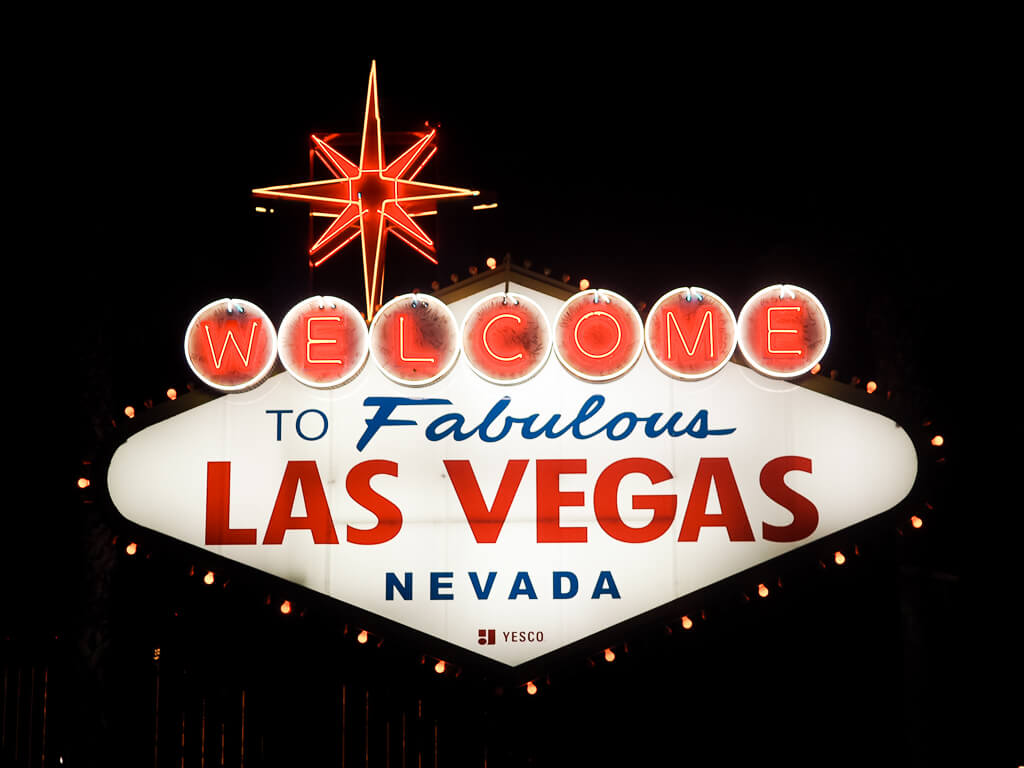
You have a few options on where to choose to start and end your Utahs National Park road trip. The more common option is to start in Las Vegas, Nevada, and Salt Lake City, Utah because they are the closest major airport to Utah’s National Parks.
However, you could also choose other destinations such as Flagstaff, Arizona, Phoenix, Arizona, or Denver, Colorado. But these options will require much more driving to get to the Utahs National Parks.
Here are some pros and cons to starting and ending in Las Vegas:
- More flight options
- Usually more affordable flight options
- Save money on a round-trip car rental and flight
- Round trip, more driving time
Here are some pros and cons to starting in Las Vegas and ending in Salt Lake City:
- No backtracking, one-way route
- Less driving time
- More money on car rental and flights
In the end, whatever works well for your time frame, budget, and travel style is how you should decide on where to start and end your Utahs National Park road trip.
The Utah road trip we suggest in this post is a round trip from Las Vegas. But you can easily alter the plan to start in Las Vegas or Salt Lake City and end in the opposite destination.
If you are lucky enough to live within driving distance of the Utahs National Parks, you don’t have to worry about catching a flight. It still would be the most convenient to start your National Park road trip at Arches National Park or Zion National Park.
How to Get to the Best National Parks in Utah
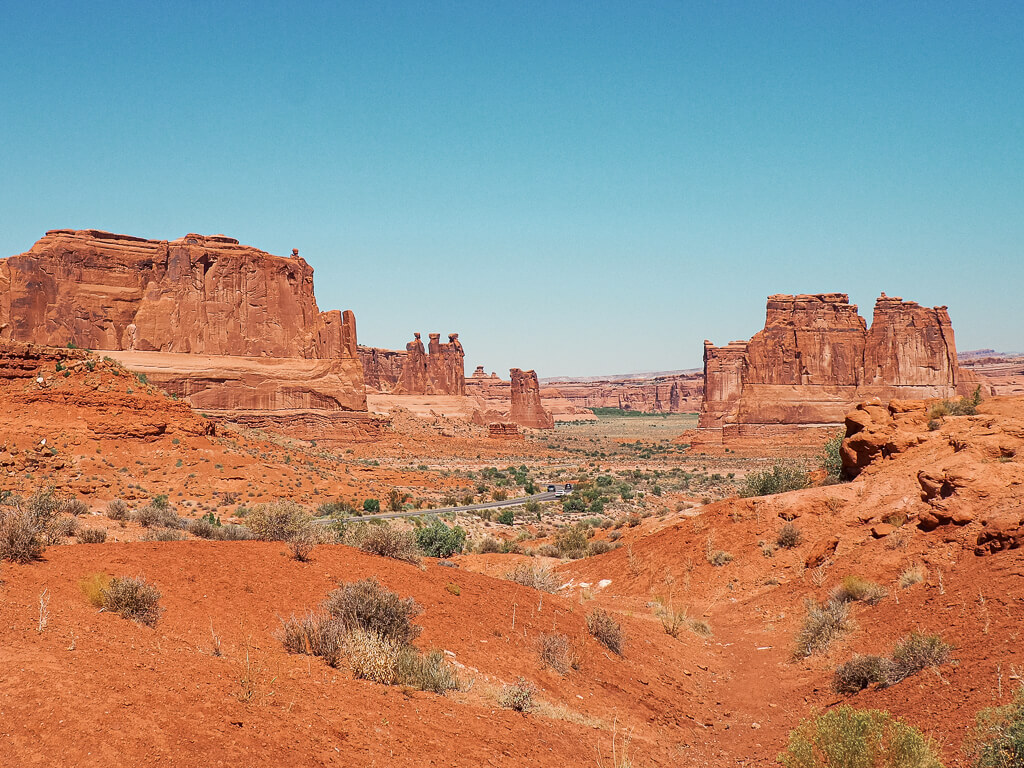
To get to Utahs National Park you will need a vehicle. Many of the Utah parks are located in more remote areas of Utah. So we recommend having your own vehicle or renting one from your starting location.
But the question is, what kind of vehicle should you rent? A car, camper, or RV.
Road tripping in Utah is perfect for a camper or RV. There are many free camping accommodations throughout the state on the numerous Bureau of Land Management lands and National Forest. If you are looking to book a vehicle like this, we would recommend checking out RV share.
But if car camping is not really your thing, renting a car will also do the trick.
Best Time to Take a Utahs National Parks Road Trip
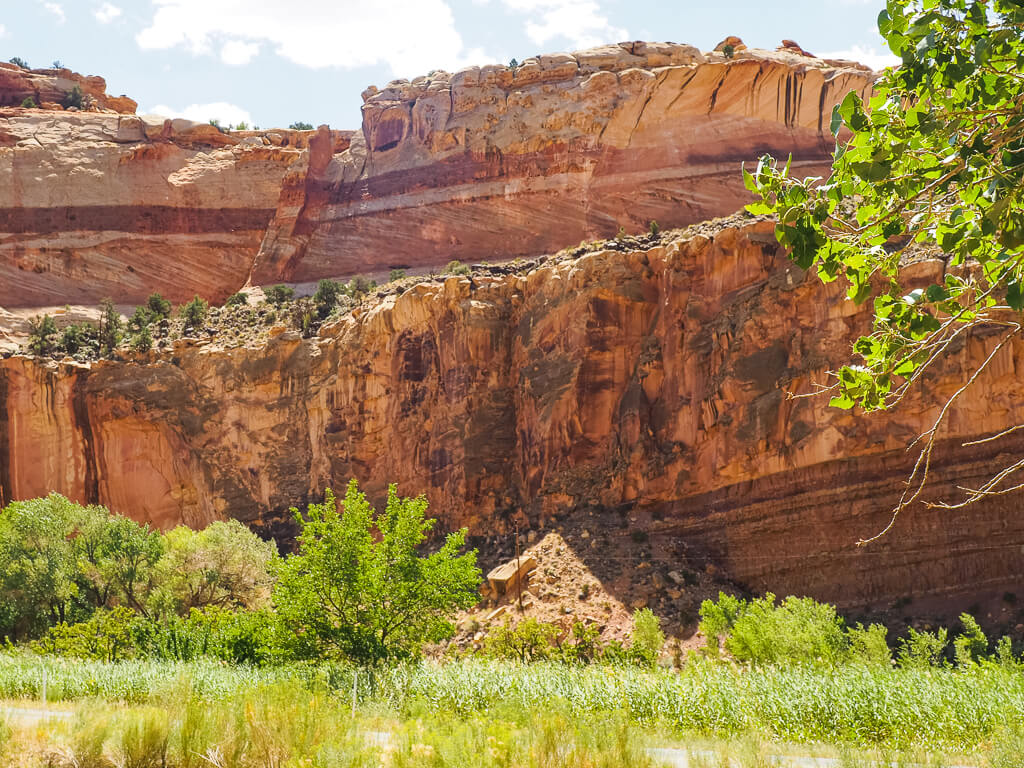
A visit to the Utah National Parks can be done all year round. Although, the overall best time to visit all of Utahs National Parks is during the spring (April-May), and fall (September-October). During these seasons, daytime temperatures are ranging from 60-80 degrees, making outdoor activities perfectly enjoyable.
Each season does provide a different and unique experience in the parks. So if you can’t make it during the ideal time, don’t worry too much. You can make it work.
10 Day Utah National Park Road Trip Itinerary
As we mentioned earlier, ideally you need 10 days to explore Utahs National Parks more in-depth. If you only have time for a 7-day Utah National Park road trip, just check our itinerary for 7 days above, and modify this 10-day trip to fit your needs and schedule.
We also wrote detailed posts about every Utah National Park. You will find the best hikes, itineraries, and more in our resource section for every park.
Utah National Parks Map: Road Trip Route
Day 1-3: Zion National Park
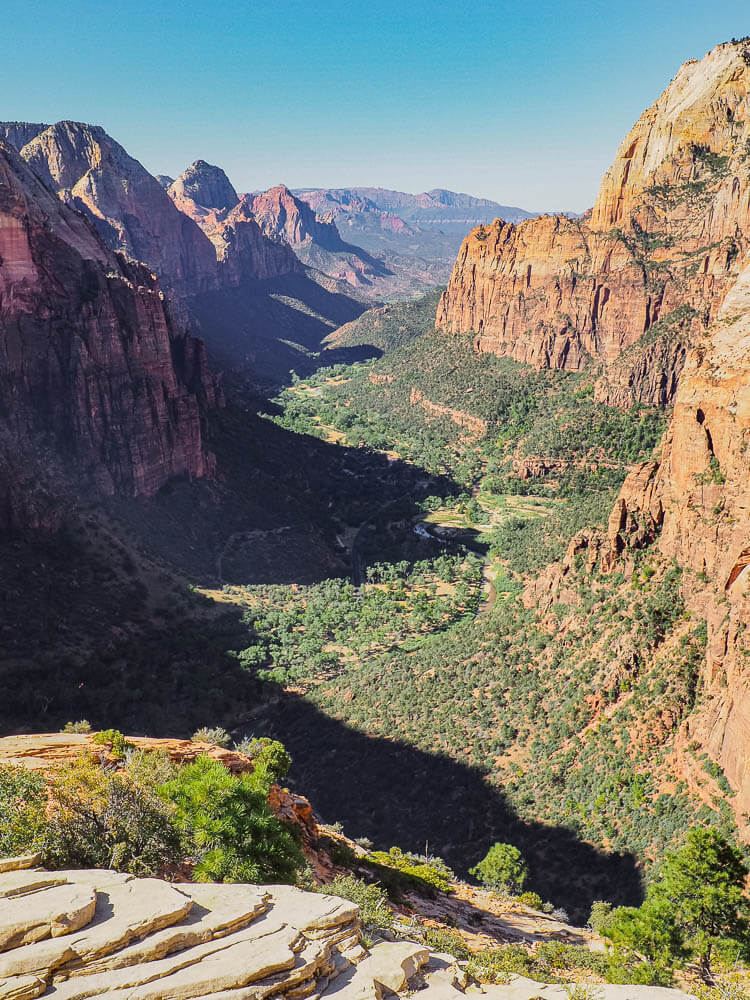
Zion National Park is one of the most-visited U.S. National Parks and on top of our all-time favorite parks list. Wondering why? You will know immediately when you arrive at this park. You will find jaw-dropping canyon sceneries and countless opportunities for thrilling outdoor activities, like canyoneering and hiking. This is by far one of the best parks for adventurous souls.
In 3 days you will be able to hike a lot of the park’s most stunning trails and can even consider an overnight trip in the backcountry. For some of the main attractions in the park, you will have to obtain a permit.
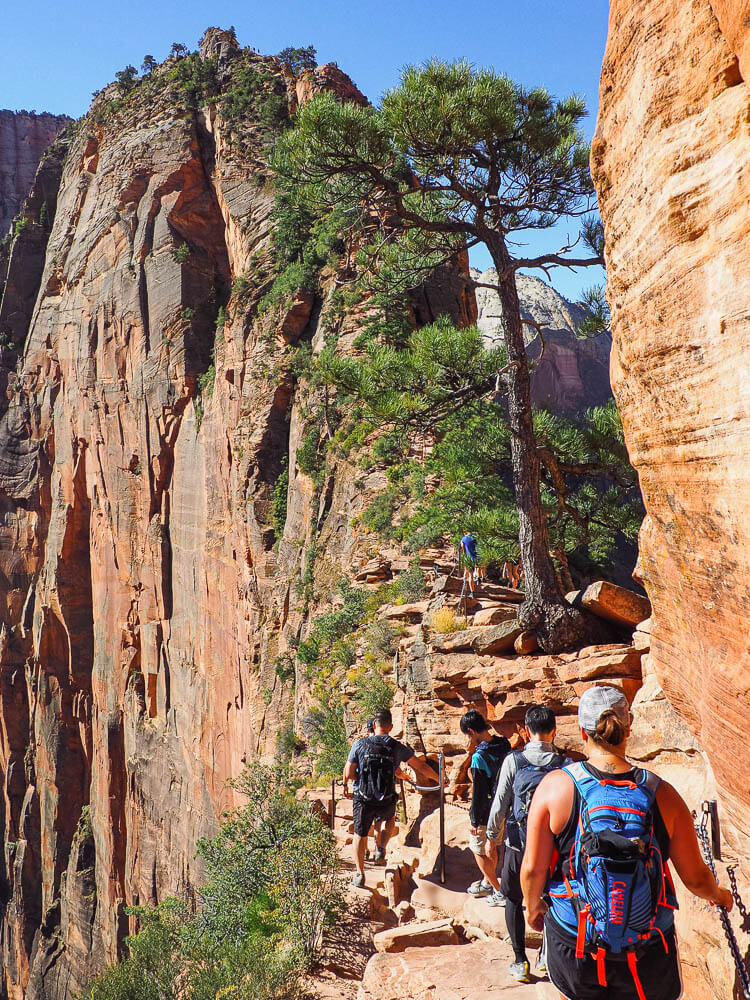
Zion National Park: Quick Look
Zion National Park Official Website
Location: 1 Zion Park Blvd, State Route 9, Springdale, Utah 84767. The drive from Las Vegas to Zion National Park will take you 2 hours 35 minutes (167 miles).
Suggested Stay: 2-3 days
Entrance Fee: $35 per vehicle (valid for 7 days)
Opening Hours: Open 24 hours. Opening Hours for facilities and shuttles change with the season. Stay up to date on the Zion National Park Service website.
Highlights: The Narrows, Angels Landing, The Subway, Zion Canyon
Fun Fact: Before Zion was a National Park it was a National Monument, known as Mukuntuweap.
Closest Airport: Las Vegas McCarran International Airport (LAS), Salt Lake City International Airport (SLC)
Park Permits:
- The Narrows – You will just need a permit for the top-down hike through this slot canyon.
- The Subway – Another slot canyon hike.
- Backcountry Permit – For overnight trips.
How to Get Around: Zion National Park has a shuttle service that accesses the main Zion Canyon section of the park from the Visitor Center to the Temple of Sinawava. Personal vehicles are not allowed on the Zion Canyon Scenic Drive when the shuttles are in service. For more information regarding the Zion Canyon Shuttle Service visit their website.
Where to Stay:
Camping – South Campground (NPS) → There are 2 more developed campgrounds in Zion National Park
Budget – Zion Glamping Adventures
Midrange – Flanigan’s Inn
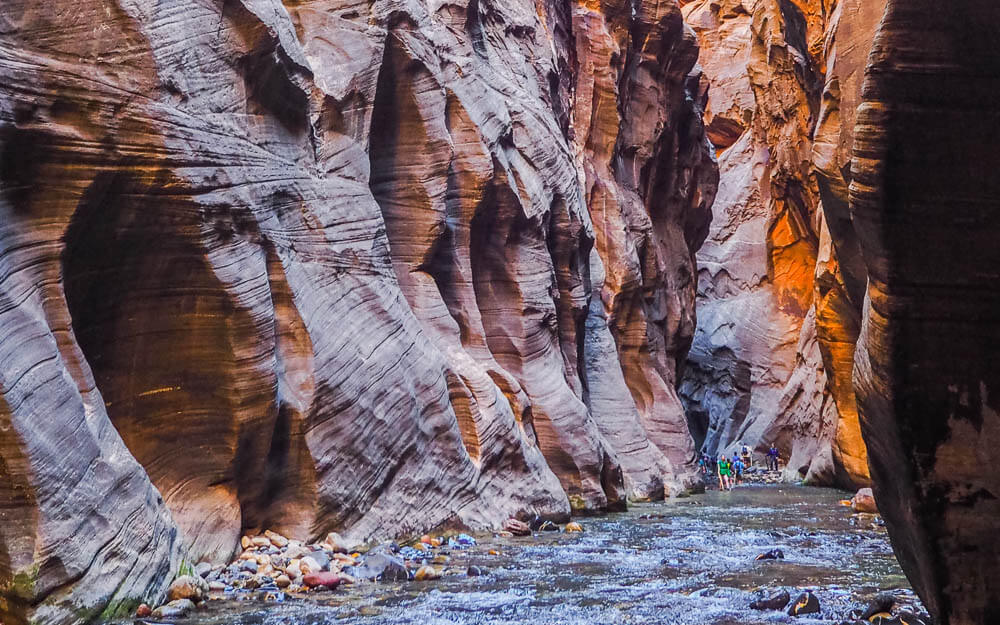
BEST THINGS TO DO
- Tour the Scenic Drives – The Zion-Mount Carmel Highway is an iconic drive through some natural sandstone tunnels you don’t want to miss.
- Hit the Trails
- Canyon Overlook Trail (1 mile, moderate)
- Emerald Pools Trail (3 miles, moderate)
- Hidden Canyon Trail (3.1 miles, moderate)
- Observation Point (7 miles, moderate)
- Angels Landing (4.4 miles, strenuous)
- The Subway (9.1 miles, strenuous)
- The Narrows (There are different routes to hike The Narrows)
- Get off the beaten path. Drive to the Kolob Canyon area, 40 miles north of Zion Canyon to find more solitude. This section offers a 5-mile scenic drive, and some stunning hiking trails, like the easy 1.1 miles Timber Creek Overlook Trail.
- Visit the Zion Human History Museum. Learn more about the American Indian culture, and early pioneers, as well as the huge effects water, has had on the park in the fascinating exhibits this museum provides.
- Go rock climbing. Zion National Park is a world-renowned location to go rock climbing. Most of the routes up the 2,000 ft sandstone cliffs are only recommended for experienced climbers though.
11 Best Hikes in Zion National Park Zion
Zion National Park Itinerary: Spend 1-5 Days
How to Hike Angels Landing in Zion National Park
A Guide to Hike The Narrows in Zion National Park
Plan a Trip from Zion to Bryce Canyon: 2 Utah National Parks
Optional Alternative for Day 1: Valley of the Fire State Park
After arriving in Las Vegas to start your Utahs National Park road trip, you can choose to make a stop at Valley of the Fire State Park in Nevada before reaching Zion National Park. Valley of the Fire State Park is a very small detour off the route to Zion.
The park has spectacular landscape views with bright red Aztec sandstone, petroglyphs, ancient trees, and bighorn sheep. You can take a drive through the park and hike some of the park’s best trails.
Next Stop:
Bryce Canyon National Park – Travel Time: 1 hour 30 minutes
When you are ready to head to Bryce Canyon National Park, leave Zion on the scenic Zion-Mount Carmel Highway to Utah 89, then continue on Highway 12.
Day 4-5: Bryce Canyon National Park
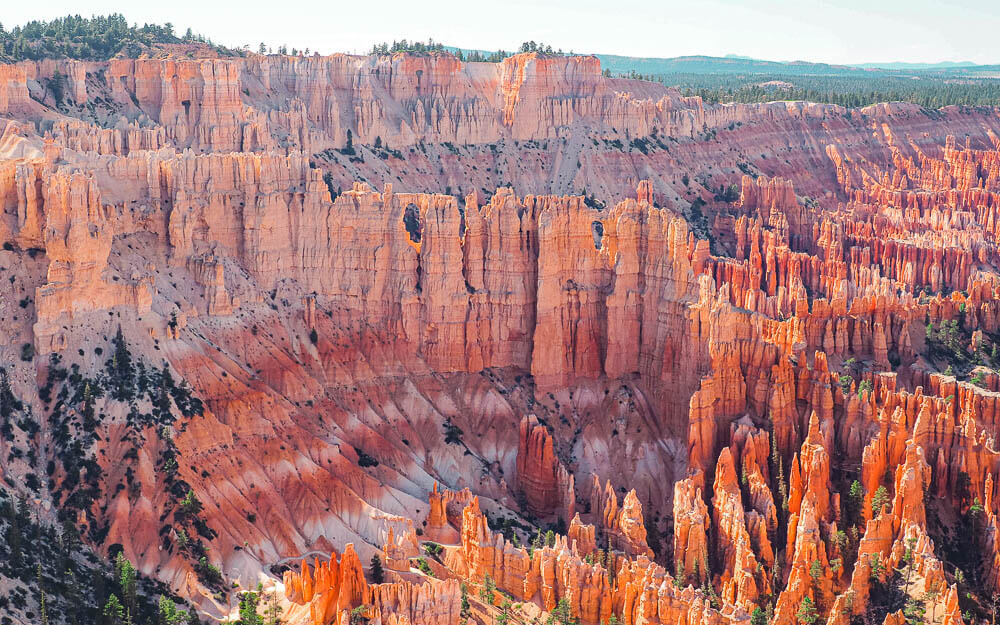
Bryce Canyon National Park is the smallest parks in Utah by size at 35,835 acres but attracts millions of visitors for its special feature. It is well known for its hoodoos and is home to the largest collection of hoodoo formations in the world. We absolutely loved to get closer to all the different patterned, and shaped hoodoos on our hikes.
Since this national park is very compact, you could see all the major highlights in 1 day. Then you would be able to squeeze in a visit to the Grand Staircase Escalante for your second day (see our recommendations to extend your Utah National Park road trip).
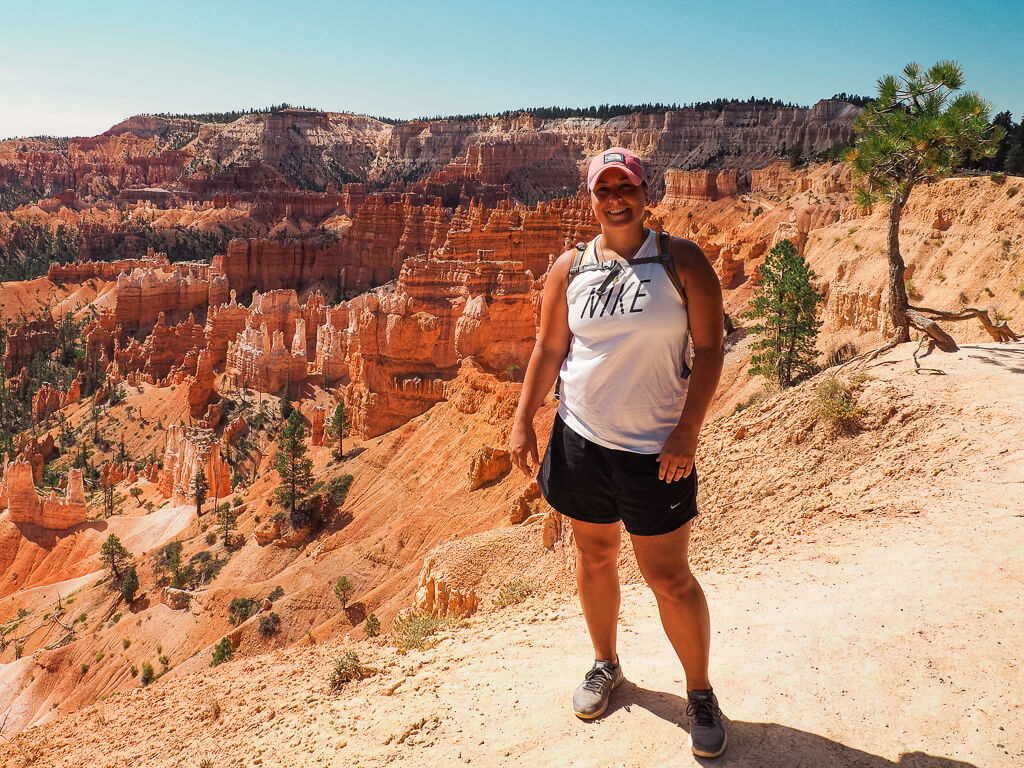
Bryce Canyon National Park: Quick Look
Bryce Canyon National Park Official Website
Location: Highway 63, Bryce Canyon National Park, Bryce, Utah 84764
Suggested Stay: 1-2 days
Entrance Fee: $35 per vehicle (valid for 7 days)
Opening Hours: Open 24 hours. Visitor Center 8:00 AM – 8:00 PM (varies depending on the season)
Highlights: Bryce Amphitheater, hoodoos, wildlife
Fun Fact: Bryce Canyon is home to some of the darkest skies in the United States, which is perfect for stargazing.
Closest Airport: Las Vegas McCarran International Airport (LAS), Salt Lake City International Airport (SLC)
Park Permits:
- Backcountry Permit – For day hikes and overnight trips
How to Get Around: There are a few different options on how you can see Bryce Canyon. You can opt to drive your own vehicle, utilize the free shuttle service (to hop on and off whenever you want), or take the free guided Rainbow Point Shuttle Tour.
Where to Stay:
Camping – North Campground (NPS) and Sunset Campground (NPS)
Budget – Bryce UpTop Lodge
Midrange – Best Western Plus Bryce Canyon Grand Hotel
BEST THINGS TO DO
- Tour the Bryce Canyon Scenic Drive. Experiencing the Bryce Canyon Scenic Drive is the easiest and quickest way to encounter the famous hoodoos. The drive runs the entire length of the park (38 miles) which allows visitors to see all angles of Bryce Canyon from the 13 viewpoints along the route.
- Hike the Trails
- Mossy Cave Trail (1 mile, easy)
- Rim Trail (3.9 miles, easy)
- Queens Garden & Navajo Loop Trail (2.9 miles, moderate)
- Peekaboo Loop Trail (5.2 miles, moderate)
- Fairyland Loop Trail (7.8 miles, moderate)
- Watch the Sunrise and/or sunset. Arrive in time to get a parking spot because watching the sunrise or setting down is a favorite activity in the park. These are some great spots to observe the spectacle:
- Sunrise Point
- Sunset Point
- Bryce Point
- Inspiration Point
Best Bryce Canyon Hikes for Your Bucket List
Bryce Canyon in One Day: What Not to Miss!
Optional Alternative for Day 5: Grand Staircase Escalante National Monument
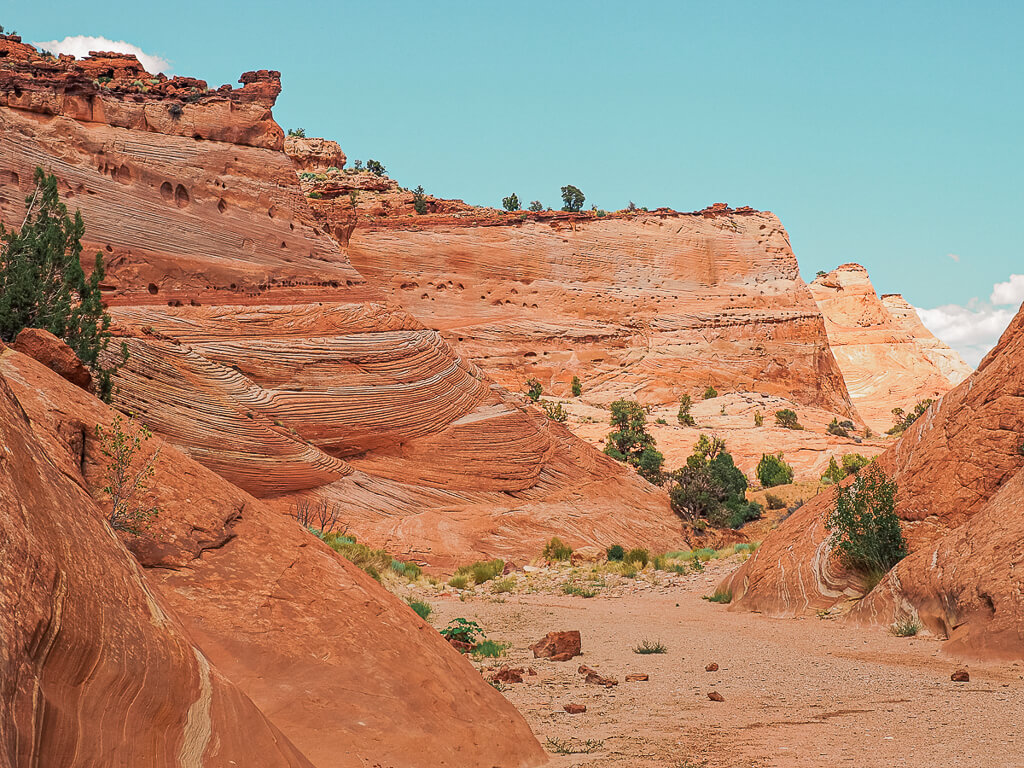
Located only a few hours from Bryce Canyon National Park, Grand Staircase Escalante National Monument is a real paradise for adventurous hikers. The most extensive network of slot canyons in Utah with phenomenal arches, waterfalls, and Slickrock is waiting for you.
You can see small bits of this amazing land when driving on The All American Road: Scenic Byway 12. But to see the best features, you will have to drive on dirt backcountry roads. It is a very bumpy ride and at some points, we were not sure if our van would make it, but you will get rewarded with some secluded slot canyon trails.
After hiking The Narrows, we couldn’t wait to experience Zebra Slot Canyon, a 5.2 miles out and back hike.
Unfortunately, the water in the canyon was so high that we couldn’t explore it fully. We swam a little between the high canyon walls but could not get deep into it. At least we could enjoy the beautiful white and pink patterned rock formations on the hike to the canyon. For more information about the Zebra Slot Canyon and other canyons in that area, check out the official Utah website.
Top Tip: Don’t forget to do some research and a little planning ahead of time to find the parking lot for the trailhead and directions to get to the canyon.
Next Stop:
Capitol Reef National Park – Travel Time: 2 hours 40 minutes
Take the slightly longer route to Capitol Reef National Park via Highway 12. The more scenic route will bring you past the Grand Staircase Escalante National Monument.
Day 6-7: Capitol Reef National Park
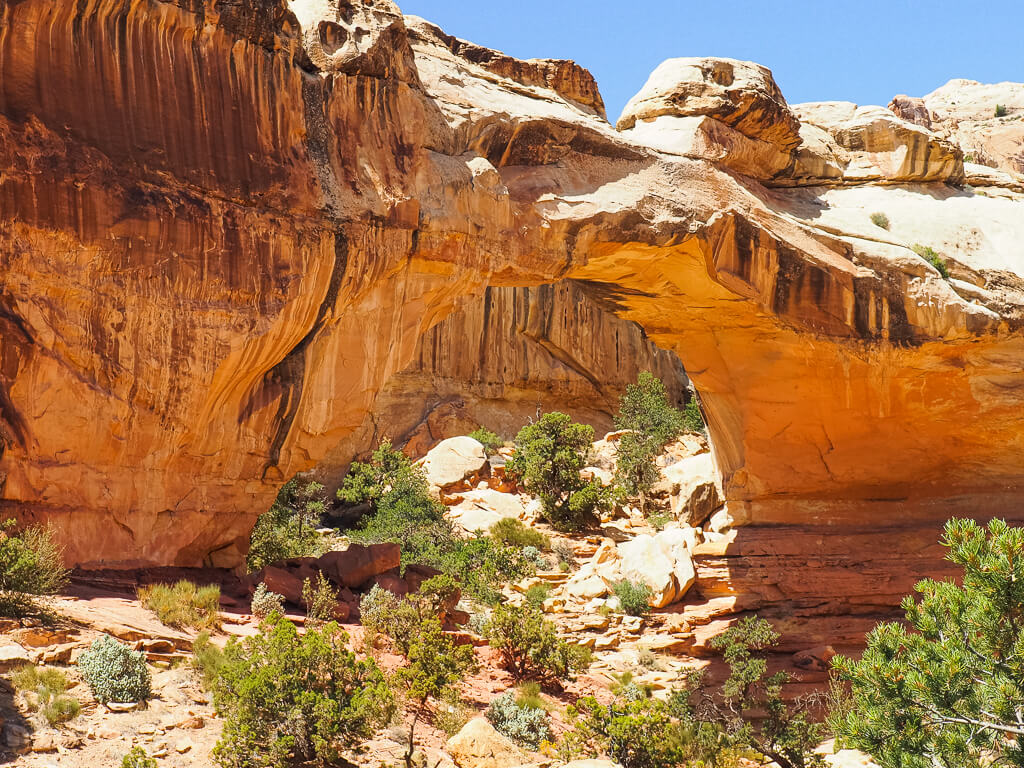
Although Capitol Reef National Park is one of the least visited national parks Utah, it is filled with a bunch of hidden gems and adventurous activities (like canyoneering) you will want to see for yourself. This park is known for the Waterpocket Fold, a geologic ‘wrinkle’ in the earth, which created stunning deep canyons you can even drive through.
We totally underestimated this national park and definitely have to come back to enjoy the various narrow canyon hikes and gorgeous rock formations in the park.
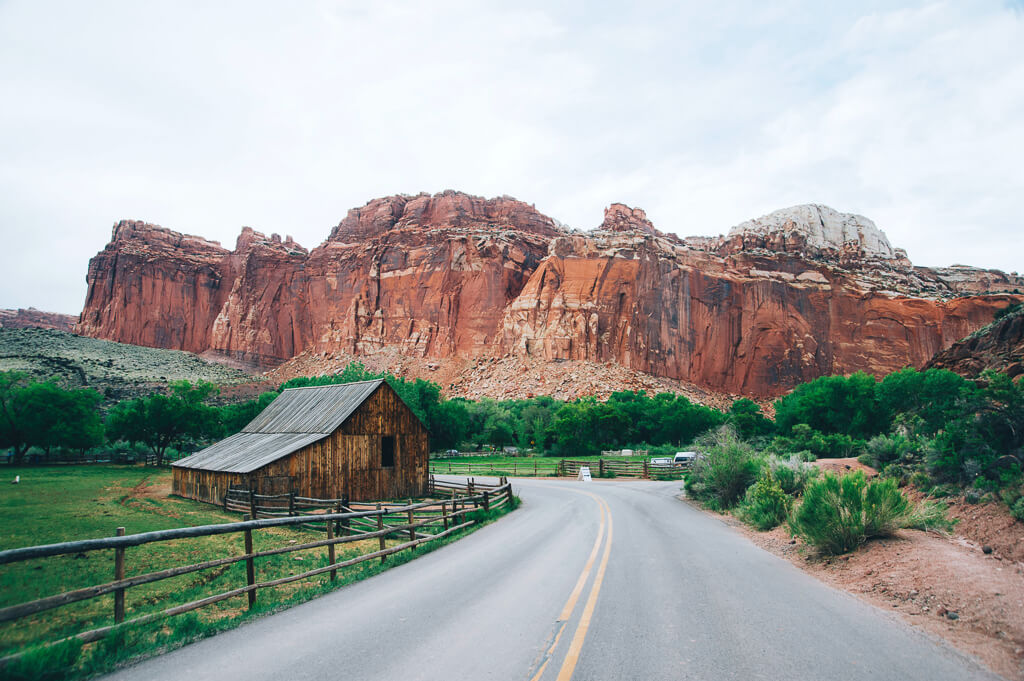
Capitol Reef National Park: Quick Look
Capitol Reef National Park Official Website
Location: 52 West Headquarters Drive, Torrey, Utah 84775
Suggested Stay: 1-3 days
Entrance Fee: $20 per vehicle (valid for 7 days)
Opening Hours: Open 24 hours. Visitor Center: 8:00 AM – 4:30 PM (vary depending on the season). Gifford House is open from March 14 to October 31: 8:00 AM – 4:30 PM (extended hours in the summer)
Highlights: Fruita District, Capitol Reef Scenic Drive, petroglyphs, Grand Wash, Hickman Bridge
Fun Fact: Capitol Reef National Park is home to the waterpocket fold.
Closest Airport: Salt Lake City International Airport (SLC)
Park Permits:
- Backpacking Permits – For day hikes and overnight trips.
- Canyoneering Permits
- Rock Climbing and Bouldering Permits
How to Get Around: Getting around Capitol Reef National Park will require the use of a vehicle. There is NO shuttle service within the park. The park is easily explored along Highway 24, which splits the park in half, and via the Scenic Drive.
Where to Stay:
Camping – Fruita Campground (NPS)
Budget – Broken Spur Inn & Steakhouse
Midrange – Capitol Reef Resort
BEST THINGS TO DO
- Hike the Trails
- Capitol Gorge (2 miles, easy)
- Grand Wash (6.9 miles or 4.4 miles, easy)
- Hickman Bridge (1.8 miles, moderate)
- Cassidy Arch (3.4 miles, strenuous)
- Sulphur Creek (5.8 miles, strenuous)
- Visit the Fruita Historic District. This area is considered the center of Capitol Reef National Park. Stop in at the Gifford House for some delicious treats or pick your own fruits in the Fruit Orchards.
- Look at the Petroglyph Panel. The colorful Petroglyph Panel is located on the rock panels of the cliffs that run parallel to Highway 24. It gives us an idea of how the Fremont and Ancestral Puebloan people lived and communicated from 600 to1300 AD.
- Tour the Capitol Reef Scenic Drive. This drive is 7.9 miles long and will take you around 1.5 hours to complete. It is a paved, easily traveled road with 2 spur dirt roads, Grand Walsh and Capitol Gorge. There are 11 viewpoints along the way.
Explore 10 Striking Capitol Reef Hikes in the Fruita District
Next Stop:
Arches National Park – Travel Time: 2 hours 15 minutes
Exit Capitol Reef National Park via Highway 24 on the east side to drive on 1-70 east towards Moab.
Day 8-9: Arches National Park
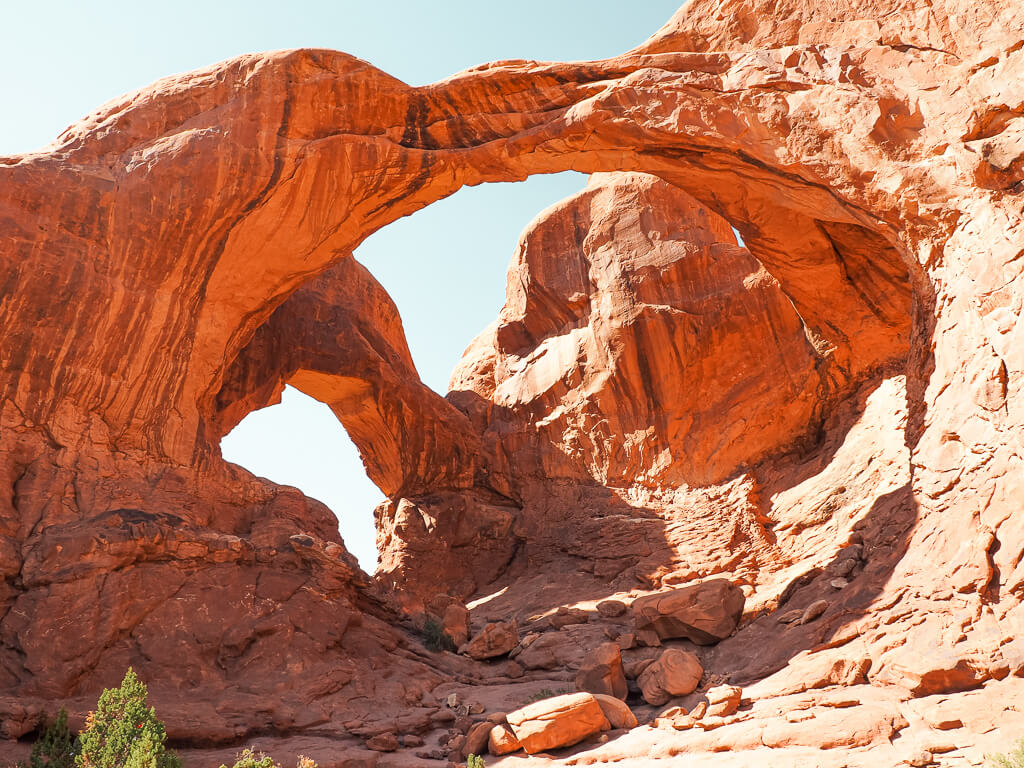
Arches National Park is famous for its 2,000 natural sandstone arches, which makes it the largest concentration of natural arches in the world. There are various hikes for every level to get up closer to these incredible natural wonders. Even after seeing a dozen of them, we promise that you won’t be bored, since they all have different features.
In 2 days, you will be able to get a lot of hikes done, even to the more secluded and adventurous areas of one of the best national parks in Utah.
If you just want to see the major highlights and stop at some viewpoints, you can also opt to visit Arches National Park in one day and use the other day to explore Moab or the Dead Horse State Park. The state park sits about 17 minutes outside of the Island in Sky district of Canyonlands.
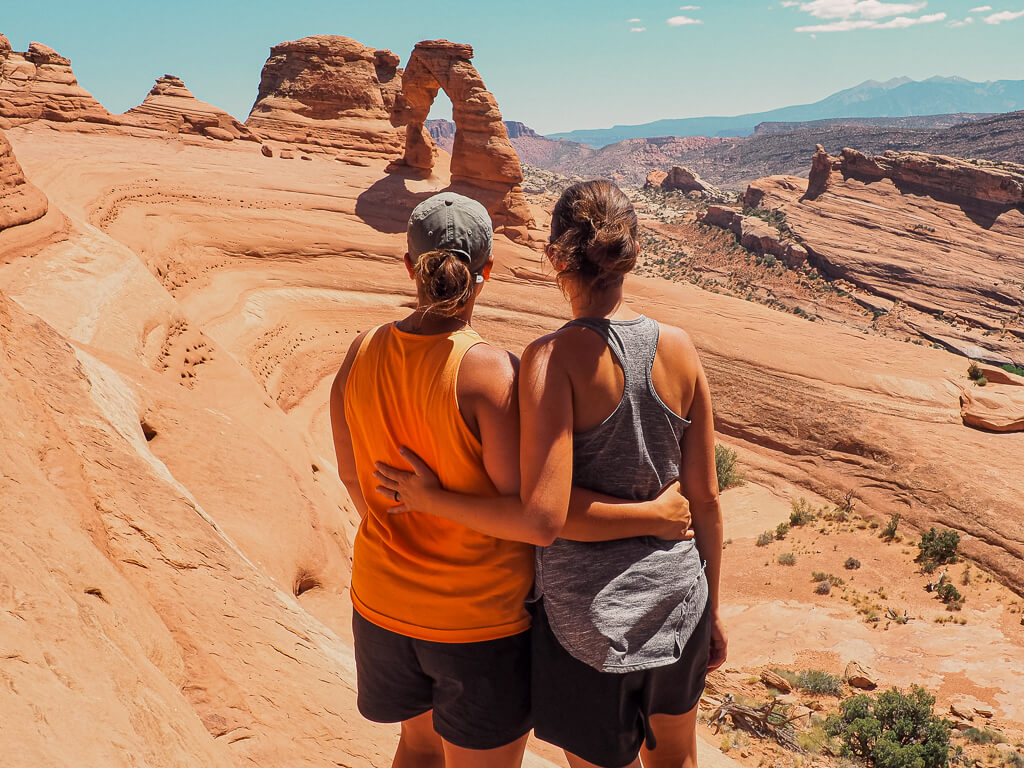
Arches National Park: Quick Look
Arches National Park Official Website
Location: 5 miles north of Moab, Utah, on US 191
Suggested Stay: 1-2 days
Entrance Fee: $30 per vehicle (valid for 7 days)
Opening Hours: Open 24 hours. Visitor Center 9:00 AM – 4:00 PM (vary depending on the season)
Highlights: Delicate Arch, Landscape Arch, Double Arch, Sand Dune Arch, Fiery Furnace
Fun Fact: Over 2,000 arches have been found and recorded in Arches National Park.
Closest Airport: Salt Lake City International Airport (SLC)
Park Permits:
- Fiery Furnace Hike – Navigate yourself through this maze of sandstone canyons and boulders.
- Backpacking Permits – For your overnight stay.
How to Get Around: The best way to travel around Arches National Park is by car. You won’t find an operating shuttle service. This national park is very easy to navigate through since there is only one entrance and one main road (Arches Scenic Drive). Some smaller roads off the main road will lead you to more secluded areas with additional trailheads. You will need approximately 1 to 1.5 hours to finish the Scenic Drive till the end.
Where to Stay:
Camping – Devils Garden Campground (NPS)
Budget – The Virginian Motel
Midrange – Under Canvas Moab
BEST THINGS TO DO
- Check out Delicate Arch – Delicate Arch is not just the largest freestanding natural arch in the park, it is also one of the most famous Utah landmarks and can even be seen on the state’s license plates. You can admire Delicate Arch from the Lower and Upper Delicate Arch viewpoint from afar or hike the 3.2 miles of moderate trail to get up close.
- Hike the Trails to Unique Arches
- Double Arch (0.5 miles, easy)
- The Windows (1 mile, easy)
- Landscape Arch (1.9 miles, easy)
- Double O Arch (4.1 miles, strenuous)
- Drive Arches Scenic Drive – This scenic route is a 36-mile-long drive through the park. Plan 3 to 3.5 hours for the whole drive, including some quick stops to enjoy the breathtaking scenery.
- Get Lost in the Fiery Furnace. Hike Arches National Park’s most challenging section, the Fiery Furnace. This area will have you twisting and turning through a narrow network of sandstone canyons, and boulders. You can also book a ranger-led guided tour.
- Watch the Stars. Arches National Park is a certified Dark Sky Park and offers excellent opportunities to watch the night sky.
8 Incredible Trails to Hike Arches National Park
Hike to Delicate Arch: The Must Do Trail in Arches
How to See Arches National Park in One Day
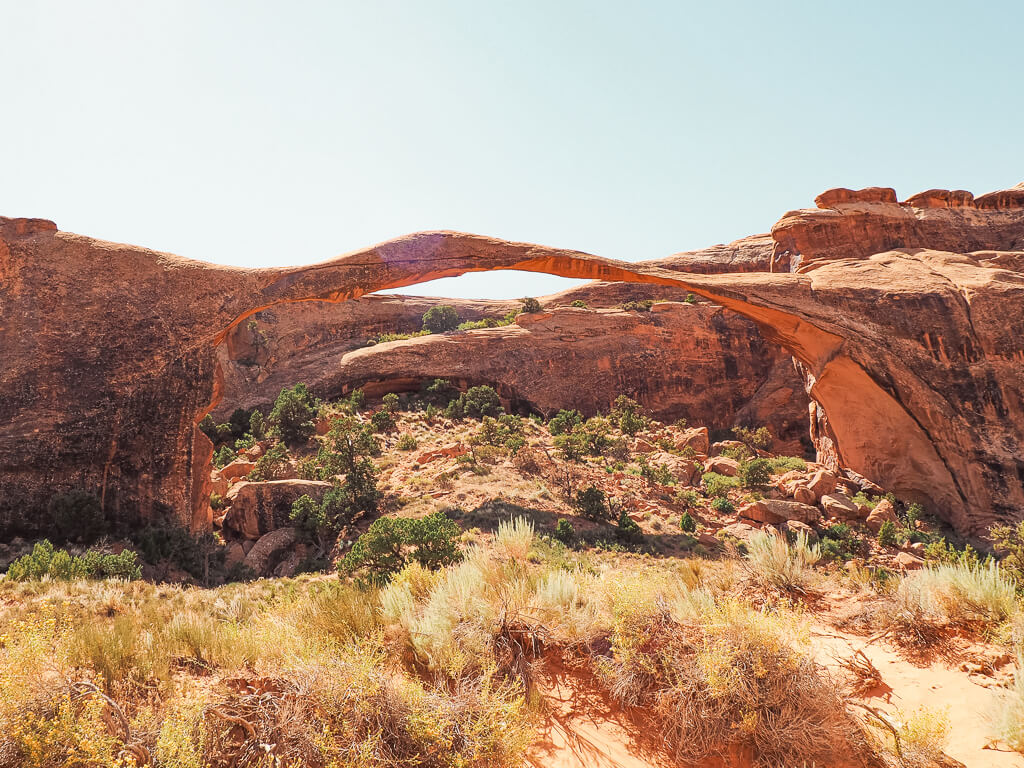
Optional Alternative for Day 9: Dead Horse State Park
Perfectly placed between Arches National Park and Canyonlands National Park, it is a splendid place to add to your Utah National Parks road trip.
It is the number 1 Utah state parks, offering dramatic views of the sensational canyon landscape.
Top Tip: The landscape in the Dead Horse State Park is very similar to the scenery in Canyonlands National Park. On top of that, you will have to pay a $20 entrance fee. Keep that in mind, when you consider visiting both of these places.
Next Stop:
Canyonlands National Park – Travel Time: about 30 minutes
Head north on US-191 and turn left onto SR-131 for the Island in the Sky district of Canyonlands National Park.
Day 10: Canyonlands National Park
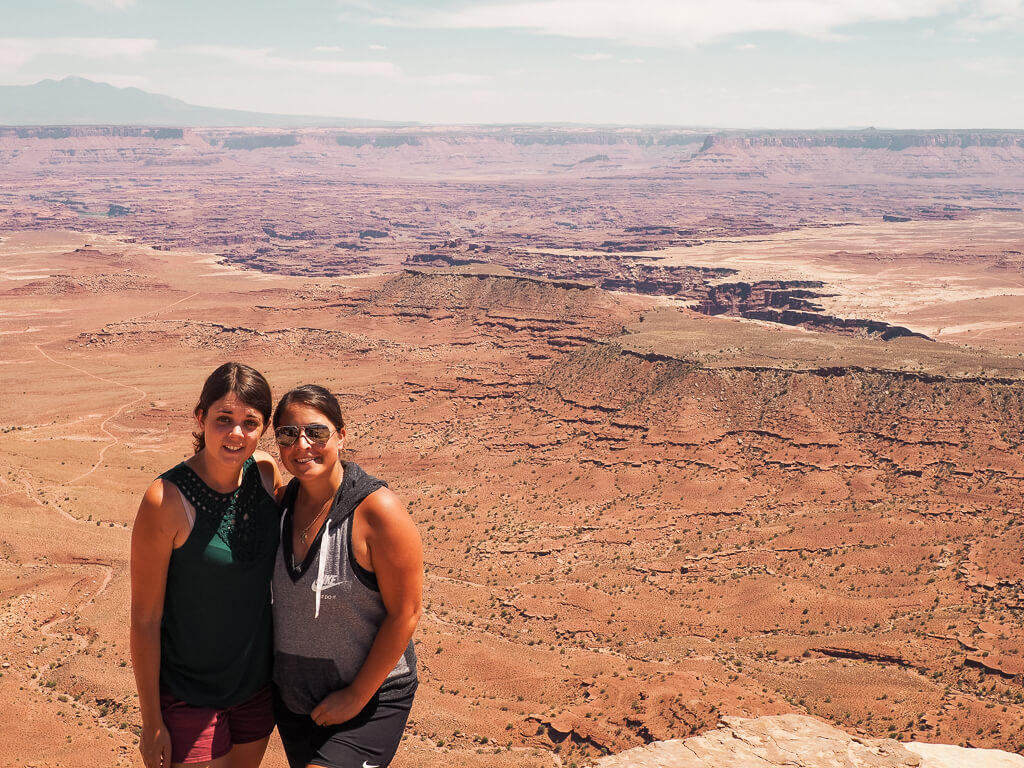
Canyonlands is a massive national parks Utah, made up of 4 distinct districts: Island in the Sky, The Needles, The Maze, and The Rivers. The sections are separated by canyons created by the Colorado and Green Rivers. Island in the Sky is the easiest, quickest, and most convenient district to visit. Expect fabulous, rough canyon vistas from every single viewpoint.
1 Day will give you enough time to get out of your car at several viewpoints and hike some of the shorter trails of the park to get even more breathtaking views.
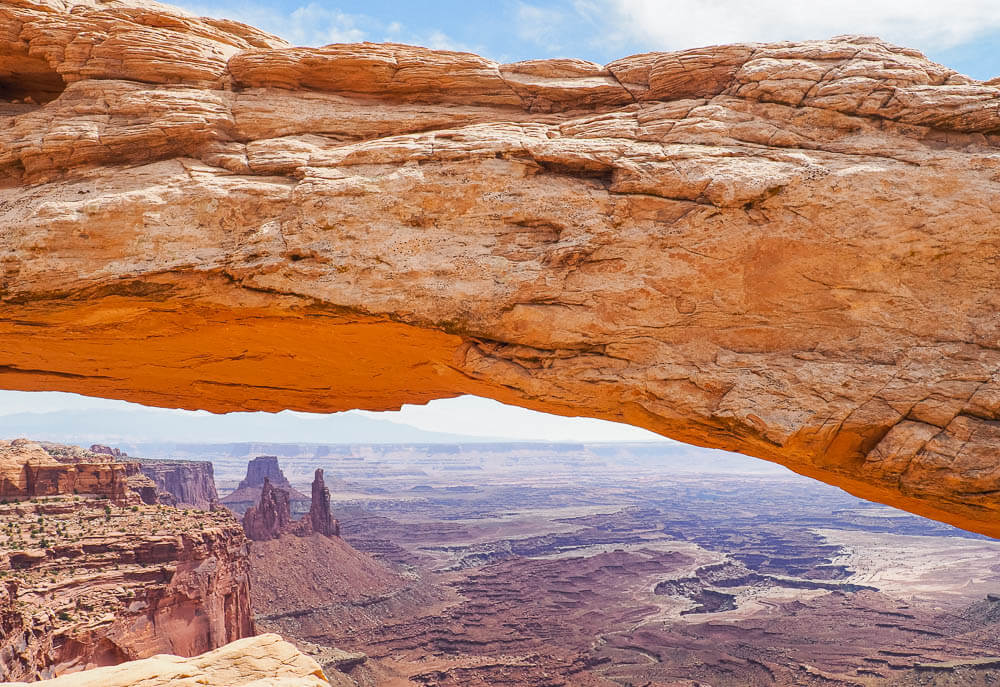
Canyonlands National Park: Quick Look
Canyonlands National Park Official Website
Location: Utah
Suggested Stay: 1-2 days
Entrance Fee: $30 per vehicle (valid for 7 days)
Opening Hours: Open 24 hours. Visitor Center 8:00 AM – 6:00 PM (varies depending on the season)
Highlights: Mesa Arch, scenic overlooks, Upheaval Dome, White Rim Road
Fun Fact: Canyonlands National Park is split up into 4 districts: Island in the Sky, Needles, the Maze, and the Rivers.
Closest Airport: Salt Lake City International Airport (SLC)
Park Permits:
- White Rim Road – Off-road adventure in Island in the Sky.
- The Needles District Roads – Off-roading Elephant Hill, Lavender Canyon, and Peekaboo/Horse Canyon roads (Salt Creek Area).
- Overnight Permits
- River Permits
- Horseback Riding Permits
How to Get Around: To explore Canyonlands National Parks, you will need your own vehicle. There is 1 main road that leads you through the Island in the Sky Canyonland district, with a few spur roads bringing you to different viewpoints and hiking trails.
There are no roads leading out to the opposite side of the park. If you would like to reach other districts of Canyonlands National Park you will need to go back out and enter through another entrance for that specific district. Expect long traveling hours to the other sections of Canyonlands.
Where to Stay:
Camping – Willow Flat Campground (NPS)
Budget – The Virginian Motel
Midrange – Under Canvas Moab
BEST THINGS TO DO
- Explore Island in the Sky. Check out the attractions in the most popular area of the park. Read more about the best of Island in the Sky Canyonlands.
- Tour the Island in the Sky District on the Scenic Drive. Make your way along the 34-mile drive and don’t forget to stop to check out the various viewpoints and go on some of the best hikes, like the Grand Viewpoint, Whale Rock, or Aztec Butte.
- Drive the White Rim Road. This route is 100-miles in length and goes around and below the Island in the Sky district. You will need a 4×4 vehicle with a high clearance to survive the rough road conditions. A permit is required.
- Hike to Mesa Arch. This natural arch is one of the most popular features in the Island in the Sky Canyonlands. That makes it one of the most recognizable and photoed spots in the park.
- Visit Upheaval Dome. This crater is a unique geological feature in the park with its impressive size of approximately three miles across.
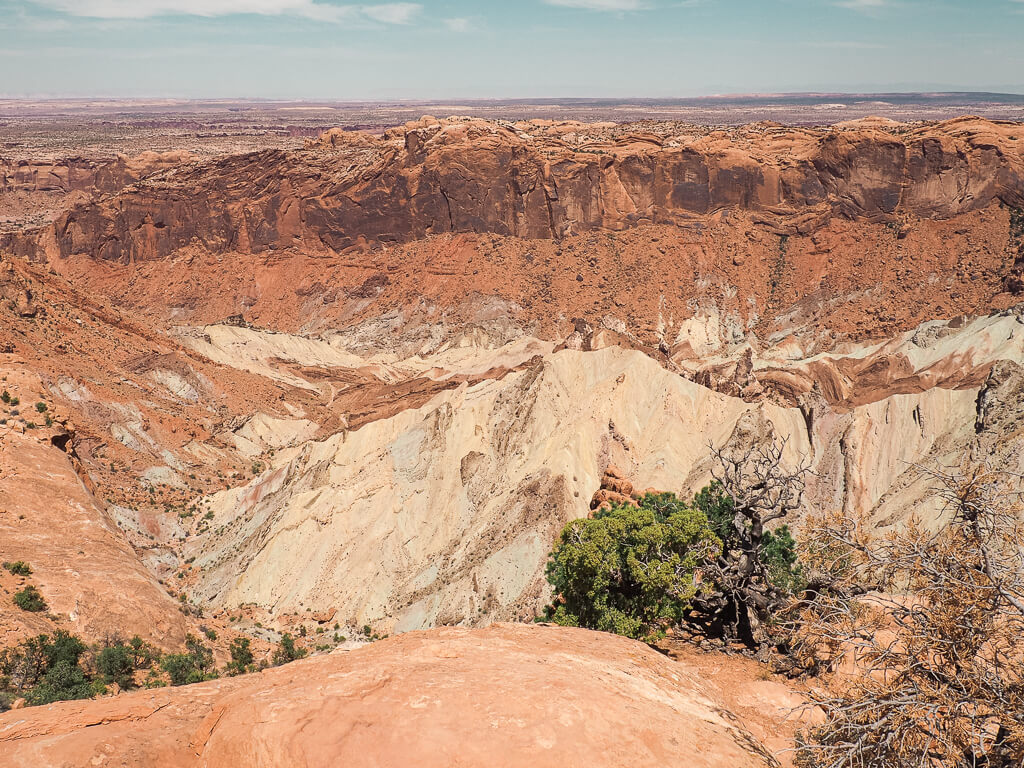
The Best of Island in the Sky Canyonlands National Park
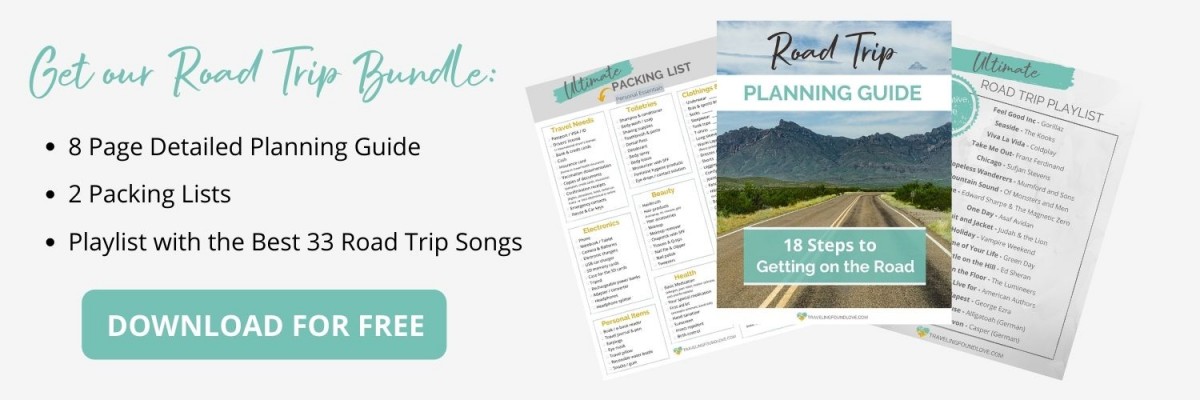
How to Extend Your Utahs National Parks Road Trip Itinerary
If you have more than 10 days to explore the surrounding area, that’s awesome. There are so many other fascinating destinations to visit, that we promise you to have the time of your life.
These are our suggestions to add to your Utah National Park road trip:
+1-2 Days: Salt Lake City, Utah
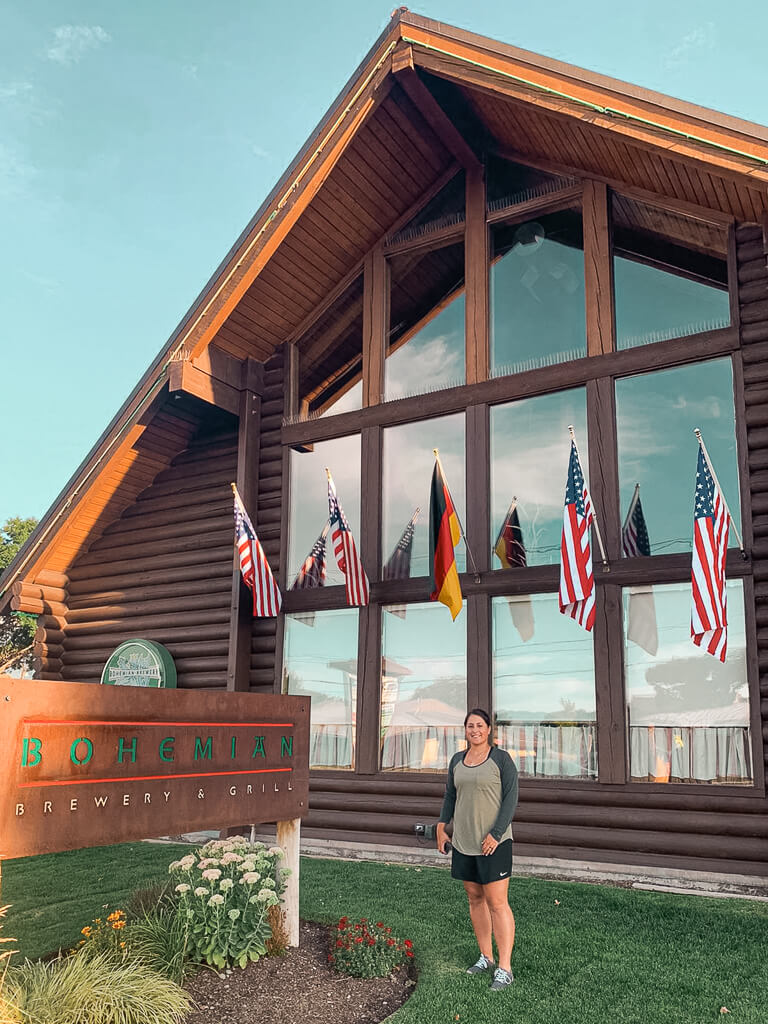
Salt Lake City is located about 4 hours from Arches National Park. It is a beautiful city surrounded by stunning mountain views. If you are up for some breathtaking hikes, make sure to check out these 7 hikes you don’t want to miss.
It is also home to the 2002 Winter Olympic Games. Visit one of the city’s most famous attractions, the Olympic sites, to get to know more about the big event. Since you will most likely either be starting or ending your trip here, you will easily be able to add in extra time to do a little exploring.
Top Tip: For an authentic international food and drinking experience, visit Bohemian Brewery. They serve American food but also have a lot of European dishes, and a huge variety of different European beers for a really good price.
+1 Day: Moab, Utah
Moab is your gateway to experience the best of Utah’s outdoor adventures. Located conveniently just outside of Arches and Canyonlands National Parks, this town is a great base to explore the intriguing surroundings.
Besides spending time in Arches and Canyonlands, you can’t miss a rafting tour on the Colorado River, renting an ATV to take a ride on the slick rocks of the Sand Flats Recreation Area, or go mountain biking on the world-famous, but very technical, Slickrock Bike Trail.
After a day packed with thrilling experiences, you can stroll around in the charming, little town, and get a cool, refreshing drink and a bite to eat in the countless restaurants.
+2 Days: Las Vegas, Nevada
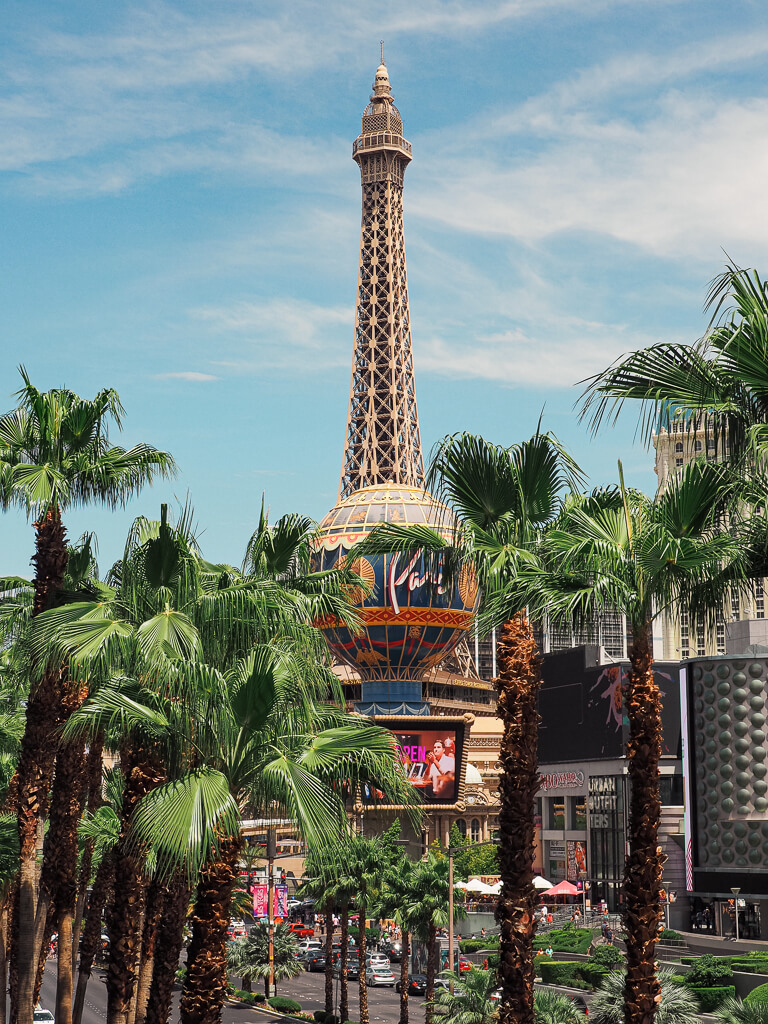
Las Vegas is just under 3 hours from Utah national parks Zion and is an absolute must-see destination. We prefer being in nature over the bustle of doing sightseeing in cities, plus we don’t even like gambling, but for one reason, Las Vegas totally fascinates us. We can’t get enough of this fun city with unlimited things to see and do.
You definitely have to stroll around the Las Vegas Strip, admiring the crazy hotel complexes, dining from first-class buffets (like the Wicked Spoon), and seeing one of the boundless fabulous shows. Also don’t forget to visit the original old Las Vegas on Fremont Street, and check out the Mob Museum to get more information on how this city became one of the most glamorous places in the world.
How to Find Free Campsites in Utah
Utah has tons of options for free camping accommodations. This makes it super easy to travel by campervan, RV, or go car camping. It is also a great way to save money on a road trip. When taking our Utah National Park road trip, we almost stayed for free every night we were on the road.
Here are some of our favorite ways to find free campsites across the United States:
- Campendium.com – This is one of our first go-to apps or website when looking for free accommodations. We love how easy it is to find a spot in our current location.
- iOverlander App – We also use this app frequently when looking for places to stay. It is very easy to use and find a campsite via the interactive map.
- The Dyrt – This is a very popular app to use as a free and paid version. The pro version of course gives you extra bonuses like a free road trip planning tool, offline access, discounts, and more.
- Freecampsites.net – Although not our favorite website to use, we have utilized it on occasion when we were stuck and couldn’t find a campsite.
Things to Know Before You Go to the Best Parks in Utah
1. Purchase a National Park Pass
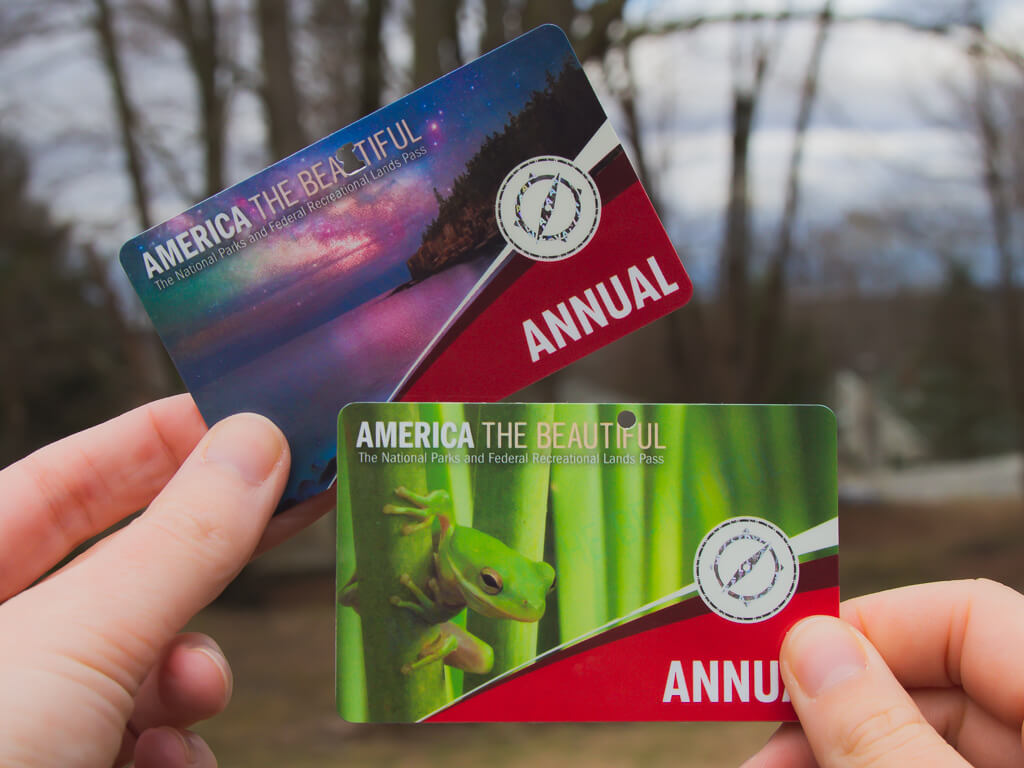
When visiting a lot of National Parks, the America the Beautiful Pass is the best purchase we can think of. It will save you big bucks.
For only $80 it gives you unlimited access to all of the more than 2,000 National Park sites for one whole year, the breathtaking east coast national parks and west coast national parks included. Too good to be true?!
Check out our detailed post about the America the Beautiful pass to get to know all the perks before visiting the west coast national parks.
2. How to Avoid Crowded National Parks
If you know anything about visiting the U.S. National Parks, then you know they can get very crowded, especially the popular Utah National Parks. So how can you avoid hitting major crowds on your visit to the Mighty 5?
- Visit during the middle of the week
- Plan a trip during the offseason
- Start your days as early as possible
- Have a plan and be prepared with your own food, drinks, and other supplies
- Explore the less popular areas of the park
3. How to Travel Around the Best Utah National Parks
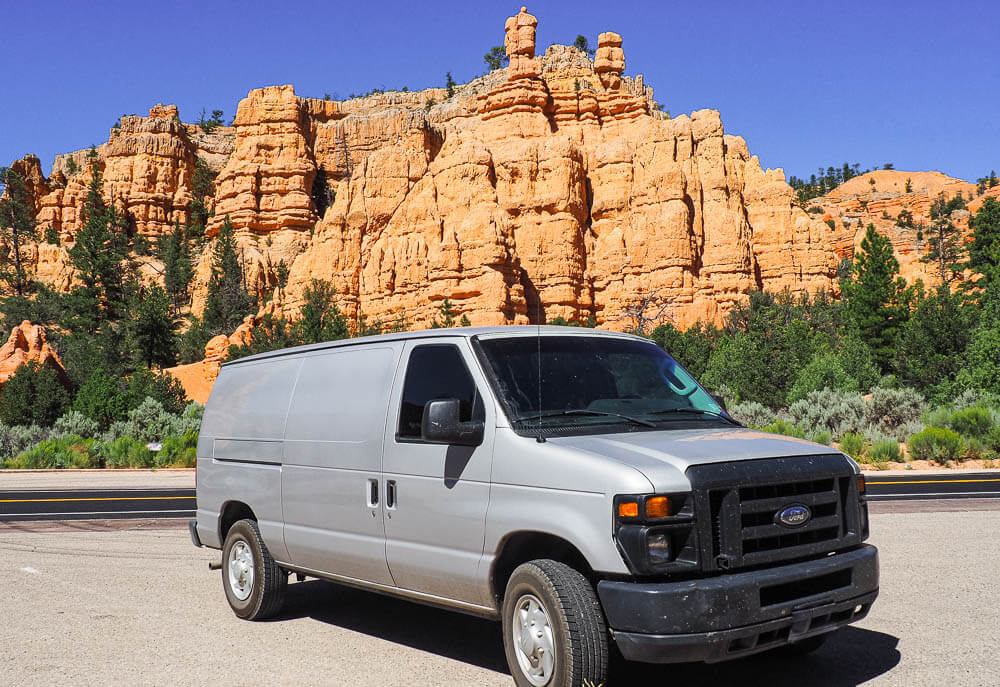
The use of a personal vehicle is a must when doing a Utahs National Parks road trip. The roads are mainly easy to drive on, so you are not in need of a 4×4 car. However, you may want a 4×4 vehicle if you plan to visit areas outside of the Utah National Parks.
One of the most important things to consider when choosing your vehicle is what type of sleeping accommodations you are looking to have.
Here are your options when it comes to getting around:
Rent a Car – If you are planning to stay in hotels or tent camping or car camping on your road trip, just renting a car should do the trick. You will find hotels, lodges, and campgrounds in close proximity to all of the parks.
Rent a Campervan or RV – If you want to enjoy nature but don’t want to do it without a comfortable bed, why not rent a campervan or RV?
We would highly recommend dispersed camping when doing your Utah National Parks road trip. You don’t get any fancy facilities (when you’re lucky you will have a restroom) but therefore, it is totally free and you will have a lot of solitude. Finding a free camping spot in Utah is extremely easy when using apps such as Campendium, The Dyrt, or iOverlander.
Here is a list of the dispersed camping sites we used when visiting Utahs National Parks:
- Zion National Park – BLM lands located on Dalton Wash Road about 30 minutes outside of the west entrance of the park.
- Bryce Canyon National Park – Forest Road 1173 (BLM lands) just outside of the park’s entrance.
- Capitol Reef National Park – Capitol Reef Overflow is just 6.5 miles from the Visitor Center.
- Arches National Park and Canyonlands National Park – Took a break from dispersed camping and stayed at Slickrock Campground in Moab, Utah.
4. Leave No Trace
Please recreate responsibly. Anytime you are exploring and enjoying the outdoors, it is important to remember to follow the Leave No Trace principles. Respect and appreciate nature, so that future generations can enjoy the same beauty. If you aren’t familiar with the Leave No Trace Principles, here they are:
- Plan Ahead & Prepare
- Travel on Durable Surfaces
- Properly Dispose of Waste
- Leave What You Find
- Minimize Campfire Impacts
- Respect Wildlife
- Be Considerate of Others
What to Pack to Visit Utahs National Parks
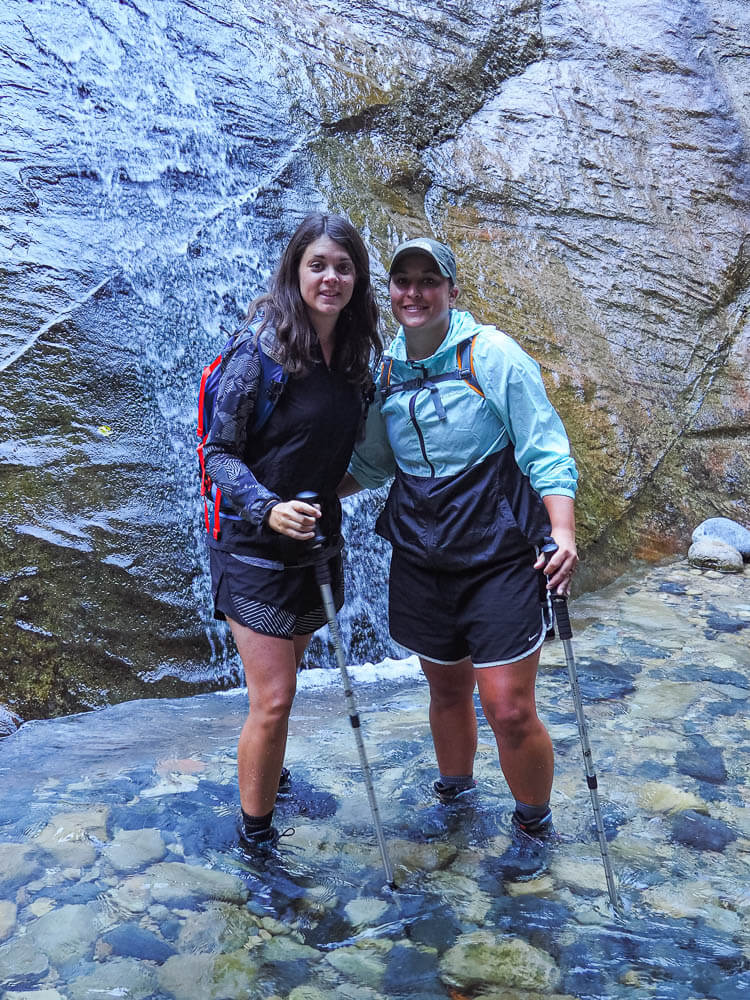
Packing for your trip to Utah’s National Parks will require some specific hiking gear for a more enjoyable experience. Here is a quick list of the hiking essentials:
Daypack – A daypack is essential for your hikes. Try out the comfortable lightweight Deuter Speed Lite daypack. It is our choice when hitting the trails in Utahs National Parks.
Water Bottle – Keep your water cool by bringing an insulated water bottle. We always carry our Hydro Flask water bottles with us.
Comfortable Hiking Boots – One of the worst things when heading out for a hike is not having comfortable footwear. For hiking in Utahs Parks, it is best to use over-the-ankle hiking boots because they provide you with good support on the more rocky and difficult terrain.
Sun Protection – Most of the trails in Utahs Parks are in the direct sun. Don’t forget to use sunscreen, a hat, and sunglasses to protect yourself from the grueling sun beating down on you.
Camera & Accessories – Don’t forget to pack a camera to capture all the memories you are about to make during your trip to Utahs National Park. Our essential camera gear is our Olympus OMD Em Mark ii, the Rollei travel tripod, a camera remote, and our Peak Design capture clip.
Road Trip Essentials – Every good road trip needs a few essentials to make the trip run smoothly. Here are some things you should consider when packing for your Utah National Parks road trip: navigation (GPS), map, phone chargers, music, insurance cards/ID, jumper cables, car fluids, road trip games, and of course lots of snacks.
Best National Parks Utah Ranking
What is the Most Visited National Park in Utah?
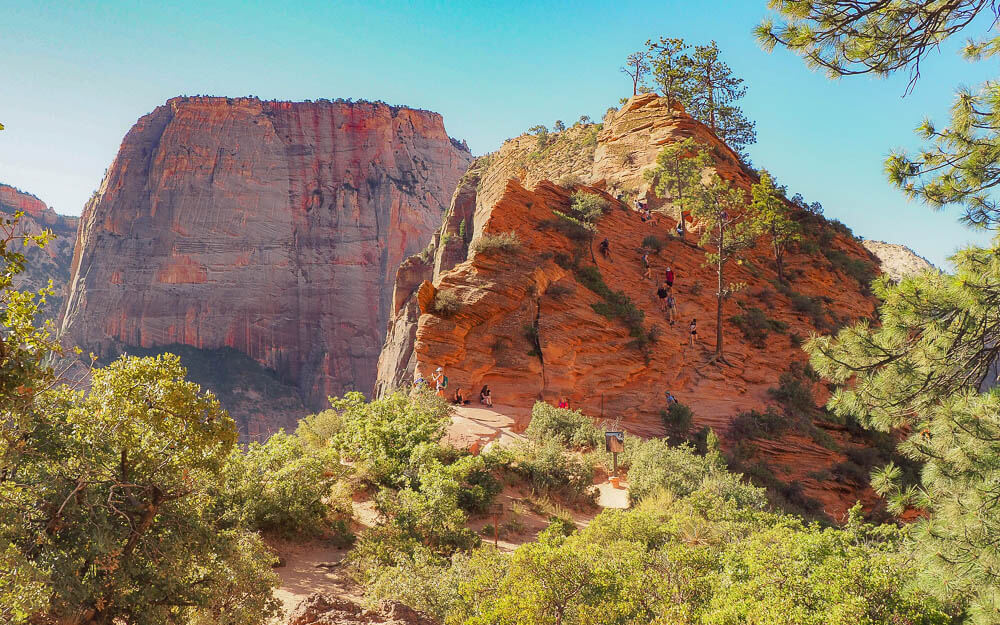
Zion National Park is the most visited of Utah’s National Parks. It was registered as the first national park in the state in 1919.
Over the years, Zion has become more and more popular. When viewing the park’s visitor statistics, you can see that millions and millions of people from all over the world visit the jaw-dropping place on earth each year. For us, that’s totally understandable. Zion’s breathtaking landscape and thrilling adventures keep visitors wanting more.
What is the Least Visited National Park in Utah?
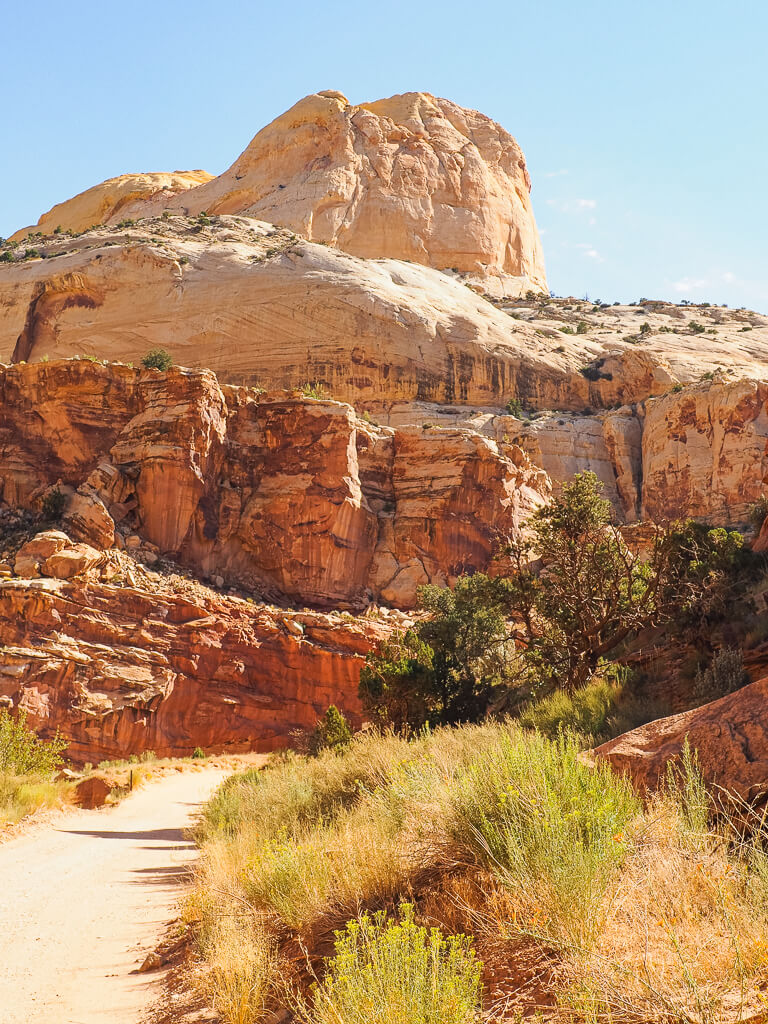
Capitol Reef National Park is the least visited of Utah’s National Parks. In December of 1971, just a month after Arches National Park officially became a national park, it was registered as the last of the Utah Mighty 5.
Although the park receives much fewer visitors a year than the other Utahs National Parks, it is no less incredible. For us, it is totally not understandable, why this hidden oasis in the center of southern Utah, doesn’t get more traffic. We loved exploring the massive slot canyons, gorgeous views, and reminiscences of past history.
Our Ranking of Utahs National Parks
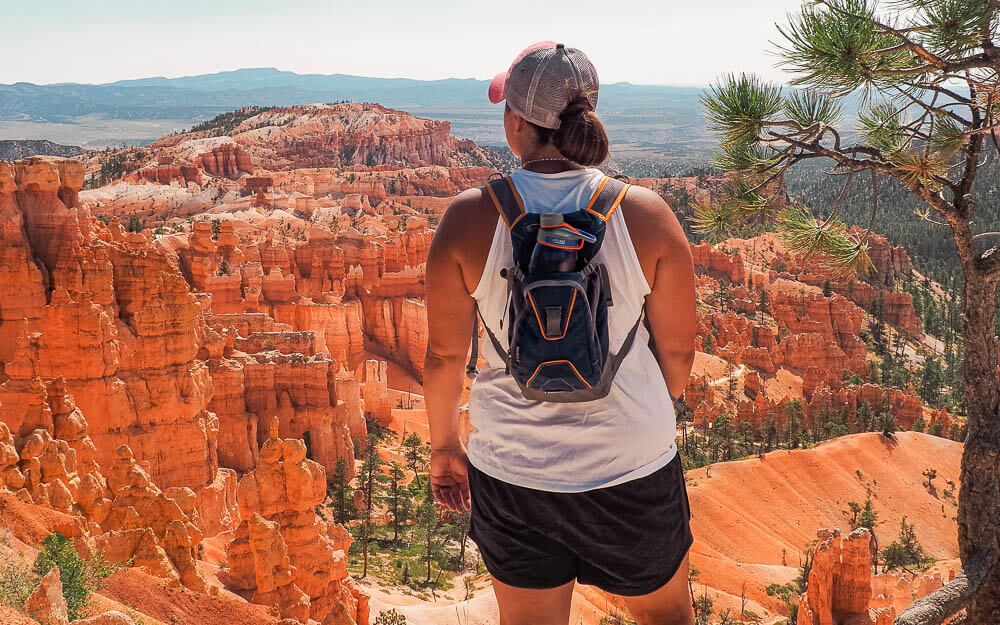
Even though all of Utahs National Parks offer various special features and unique, beautiful landscapes, some of them get a little deprived, due to their more popular neighbors. As real National Park geeks, there was no doubt that we had to visit all of the Mighty 5 in Utah.
If you have the time, we would definitely recommend seeing them all. If you are in a rush and really have to make a decision on which one to see, the ranking from our favorite to our least favorite national park might help you. Please remember, this ranking is solely based on our interests and experiences from visiting the parks. Your ranking may look different.
- Zion National Park
- Arches National Park
- Bryce Canyon National Park
- Capitol Reef National Park
- Canyonlands National Park
Which of Utahs National Parks is your personal favorite? What adventure did you enjoy the most?
Share your experiences with us or drop a question in the comments below!
You May Also Like:
- Road Trip Across the United States: 9 Week Itinerary
- Plan a Trip from Zion to Bryce Canyon: 2 Utah National Parks
- 31 Best Games for Road Trips for Adults to Beat the Boredom
- 90+ Road Trips Quotes to Excite You to Hit the Road
- 45 Useful Gifts for Road Trips You Didn’t Know You Needed
- 100+ Tested Road Trip Pack List Essentials You Will Not Want to Forget
- 16 Best East Coast National Parks You Need to Visit
- 34 Best West Coast National Parks + Western U.S. Parks that Will Blow Your Mind
- A Complete National Park List by State + Downloadable Checklist and Map
- First Hand Ranking of National Parks in USA from Best to Worst
Save this Post for later on Pinterest!
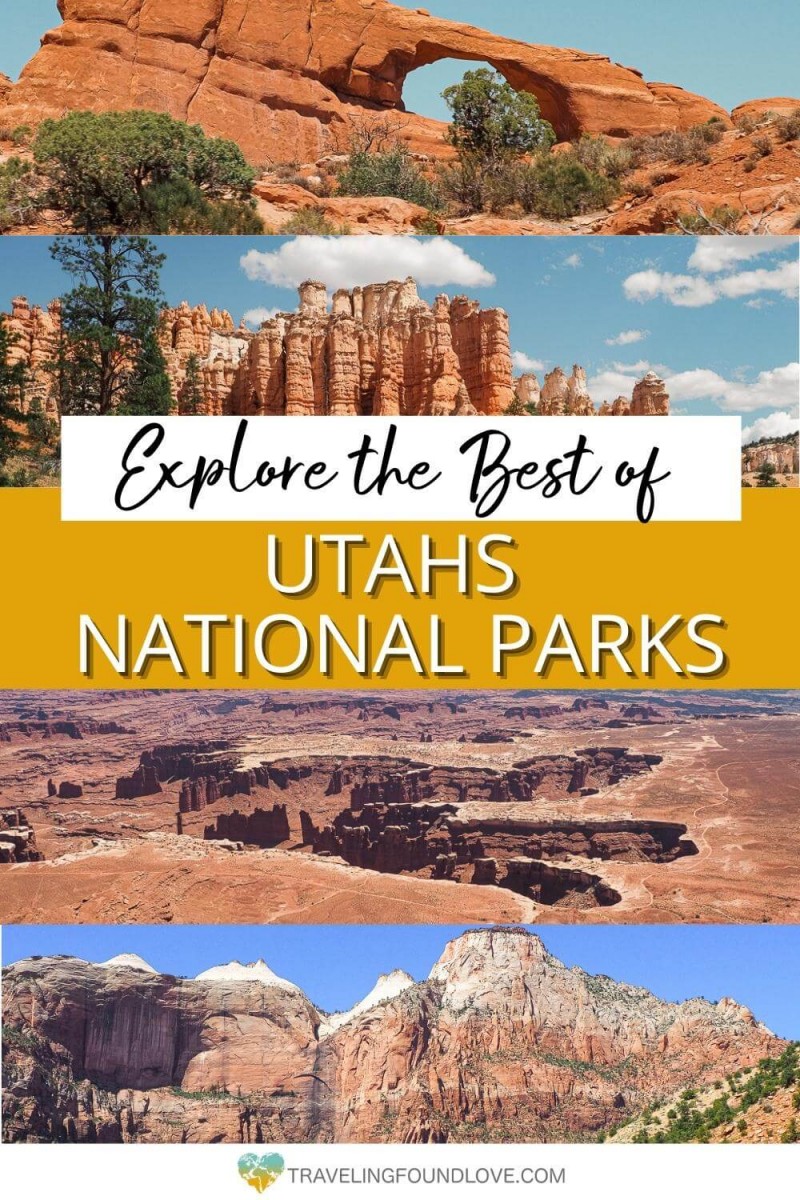
Did you like this post? Subscribe to our newsletter and we’ll send you more unique travel tips, updates, and even FREE content!
